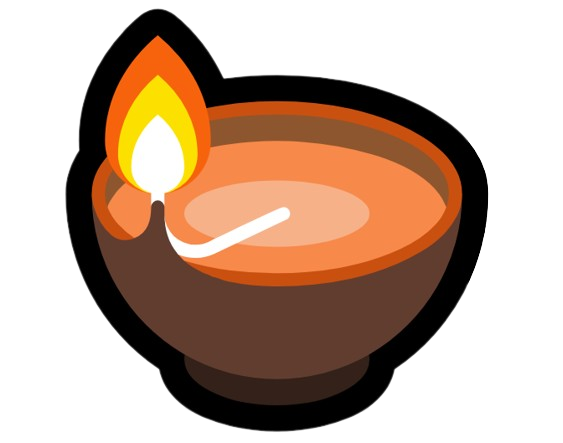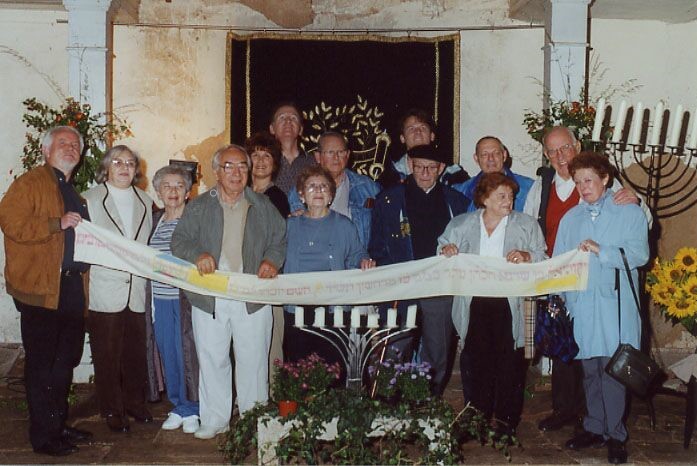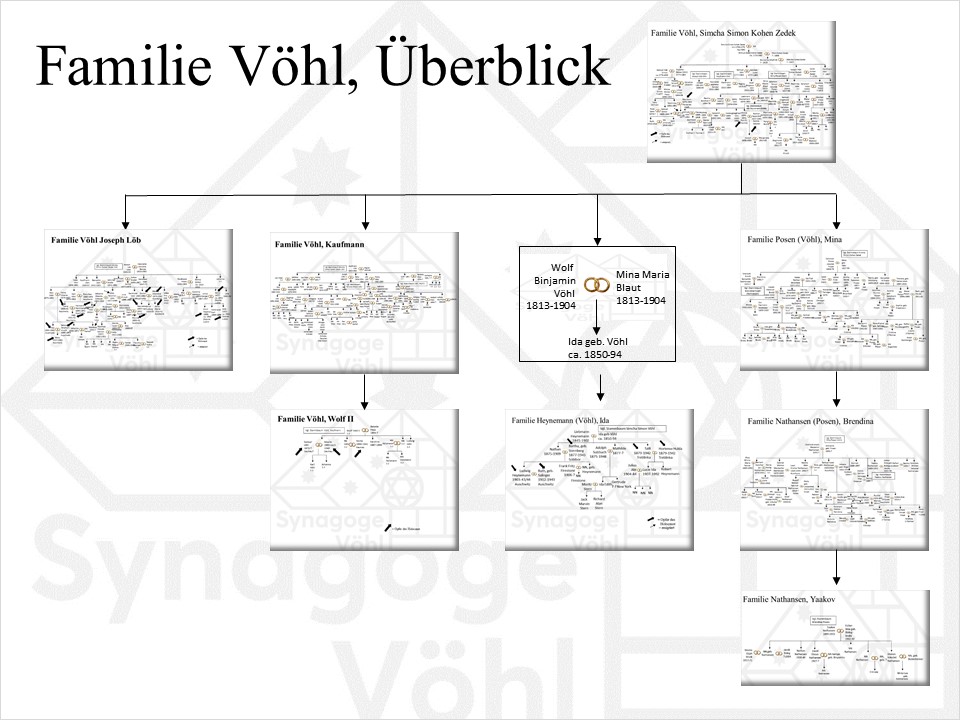-Erik Peper worked with the program "Adobe Photoshop®" -
Based on an old photo and the floor plan, he returned the sacred space to its original furnishings.
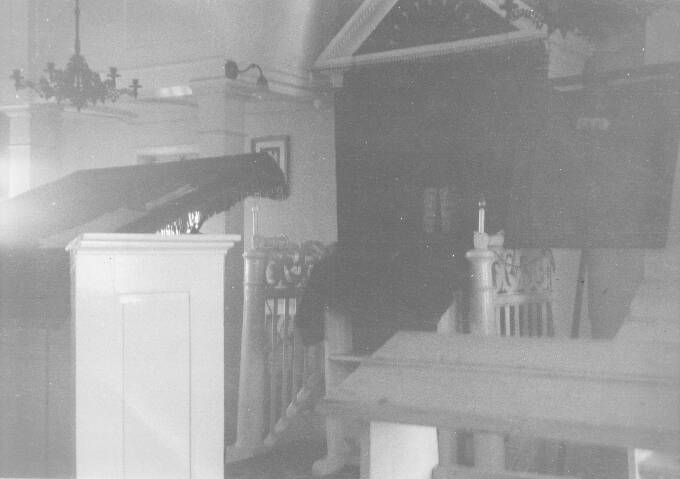
The only surviving picture of the interior of the synagogue; early 1930s Photo: Ernst Davidsohn (1921-95) Donated by C. Baird (descendant of the Frankenthal family from Vöhl)

Taken from:Thea Altaras, Synagogues and Jewish Ritual Immersion Baths in Hesse - What has happened since 1945?, Darmstadt 2007
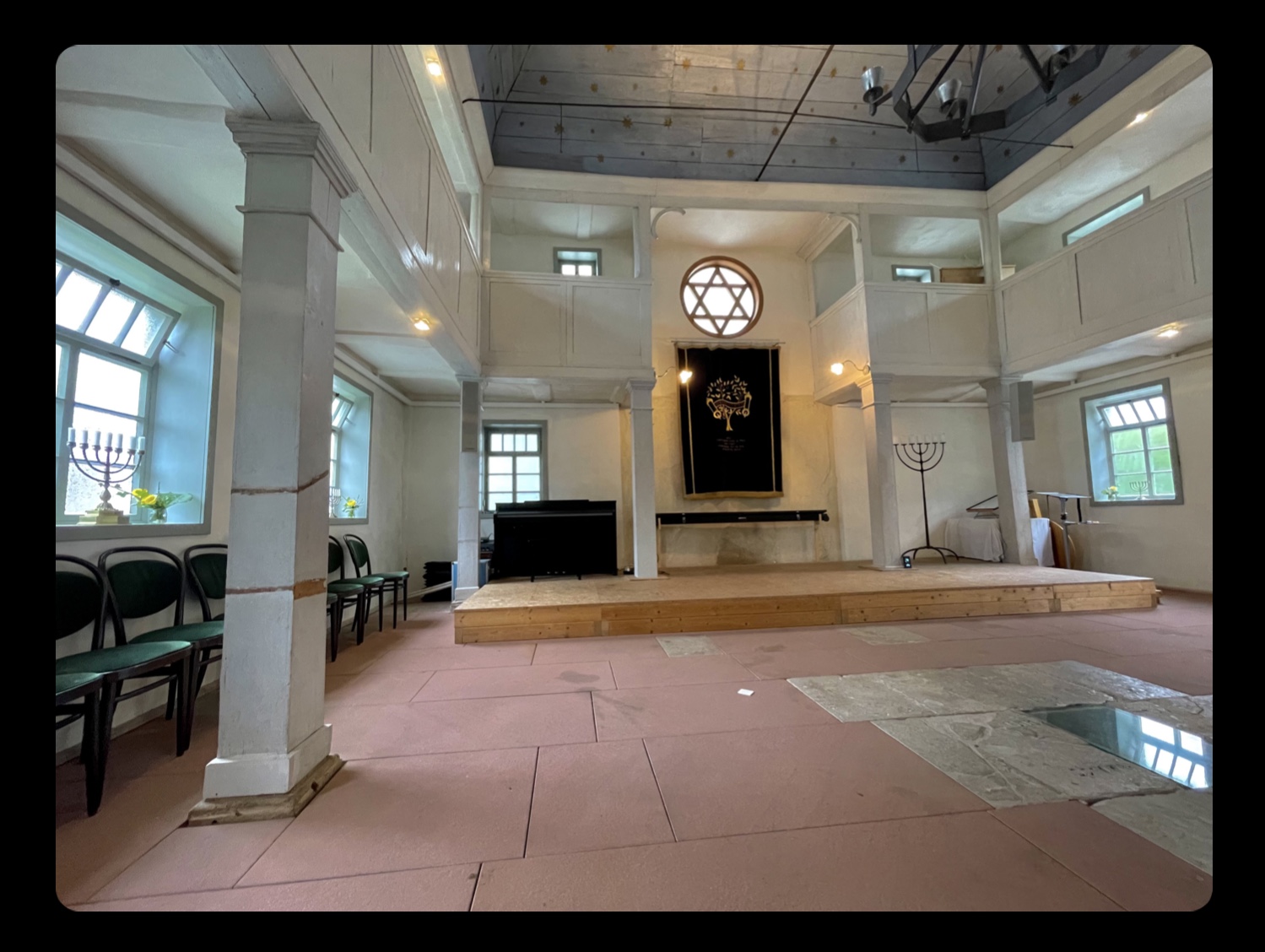
 And measured.
And measured. The rest of the work is done on the computer.
The rest of the work is done on the computer. Firstly, the current furniture is removed from the room.
Firstly, the current furniture is removed from the room.Here it already has a floor covering modelled on the old one.
 Then it is refurnished.
Then it is refurnished. |
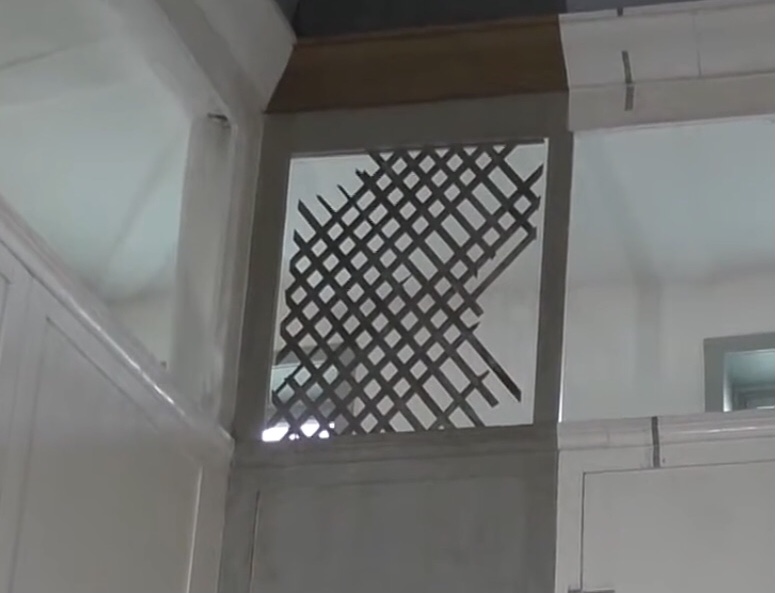 |
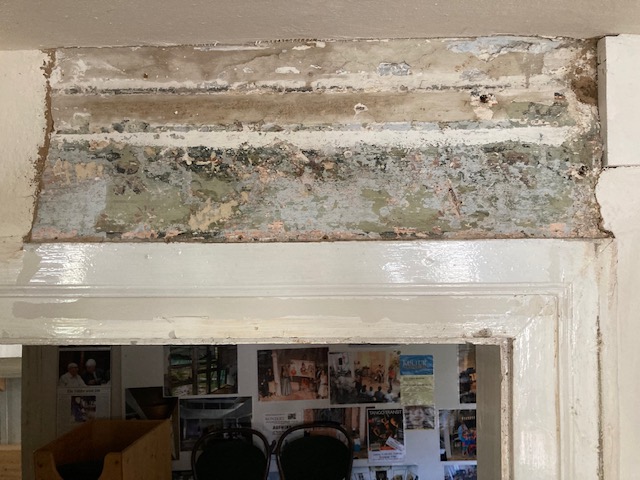 |
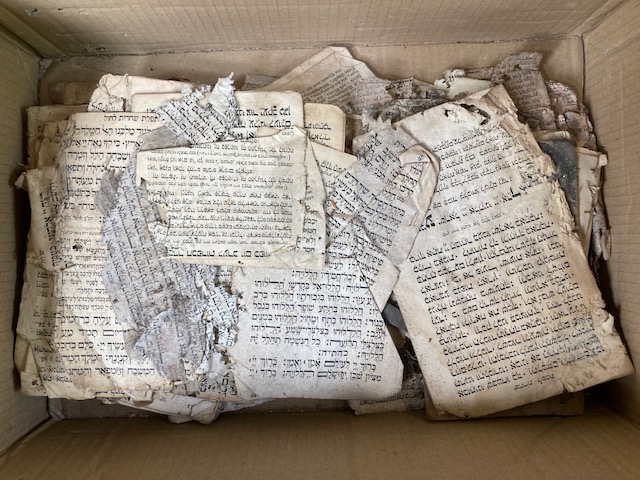 |
 |
 |
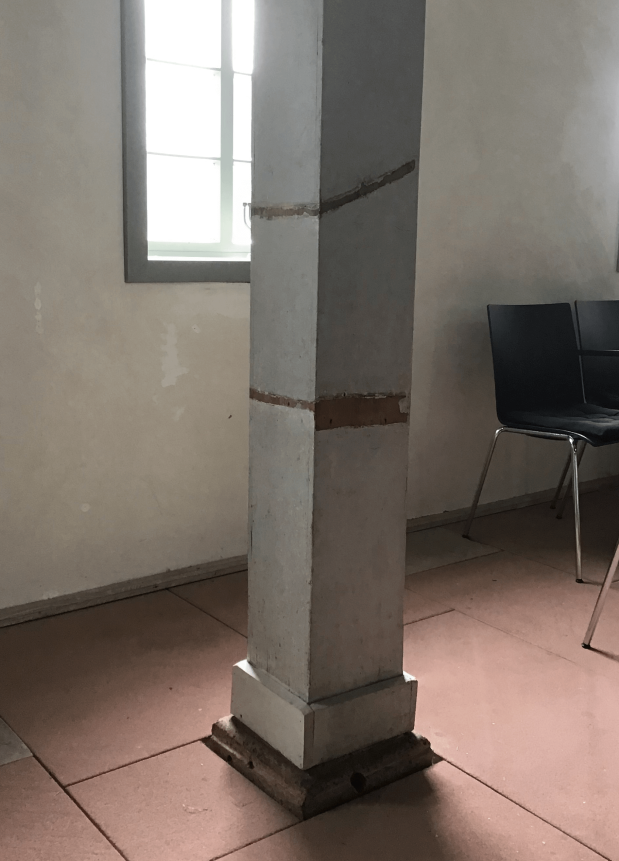 |
 |
 |
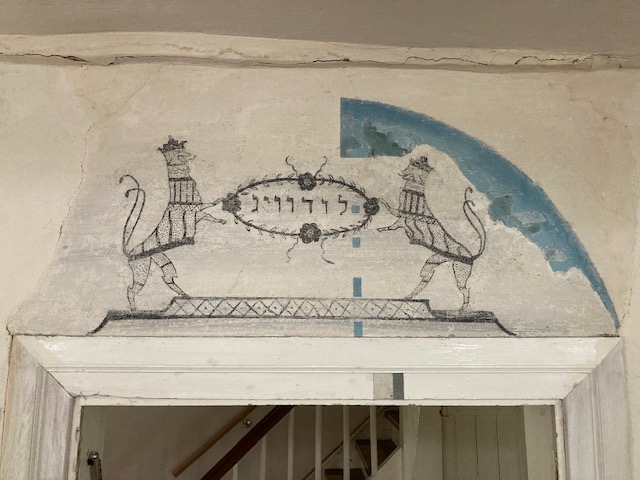 |
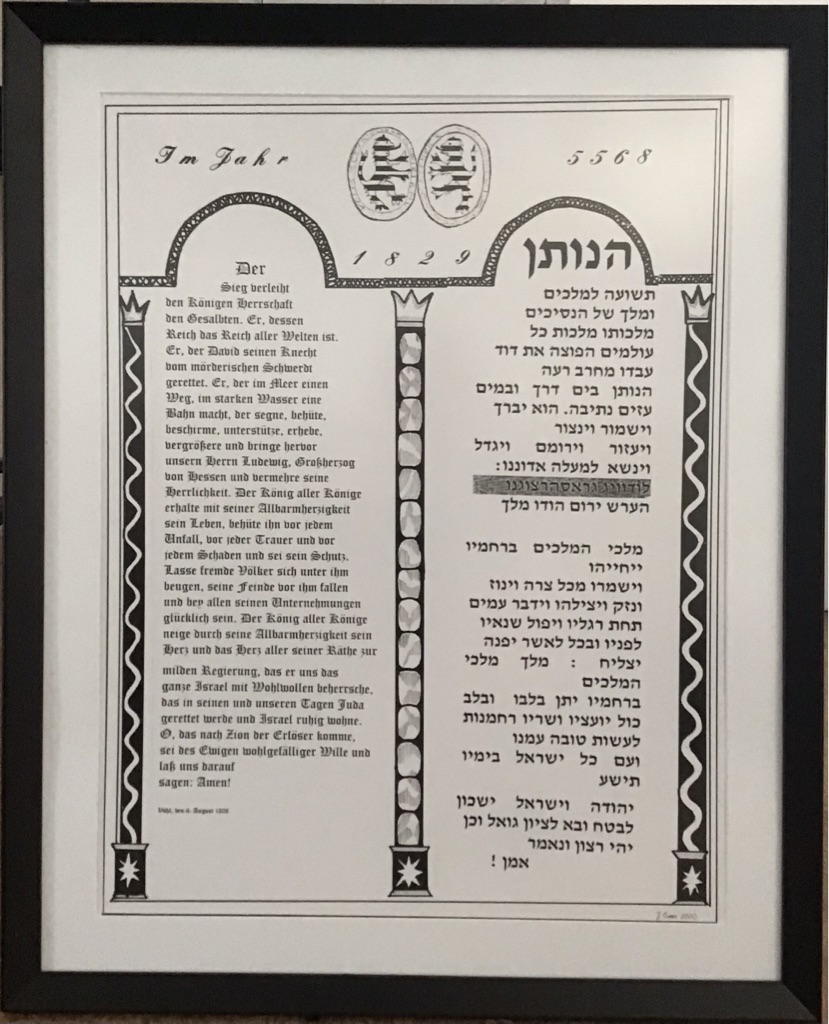 |
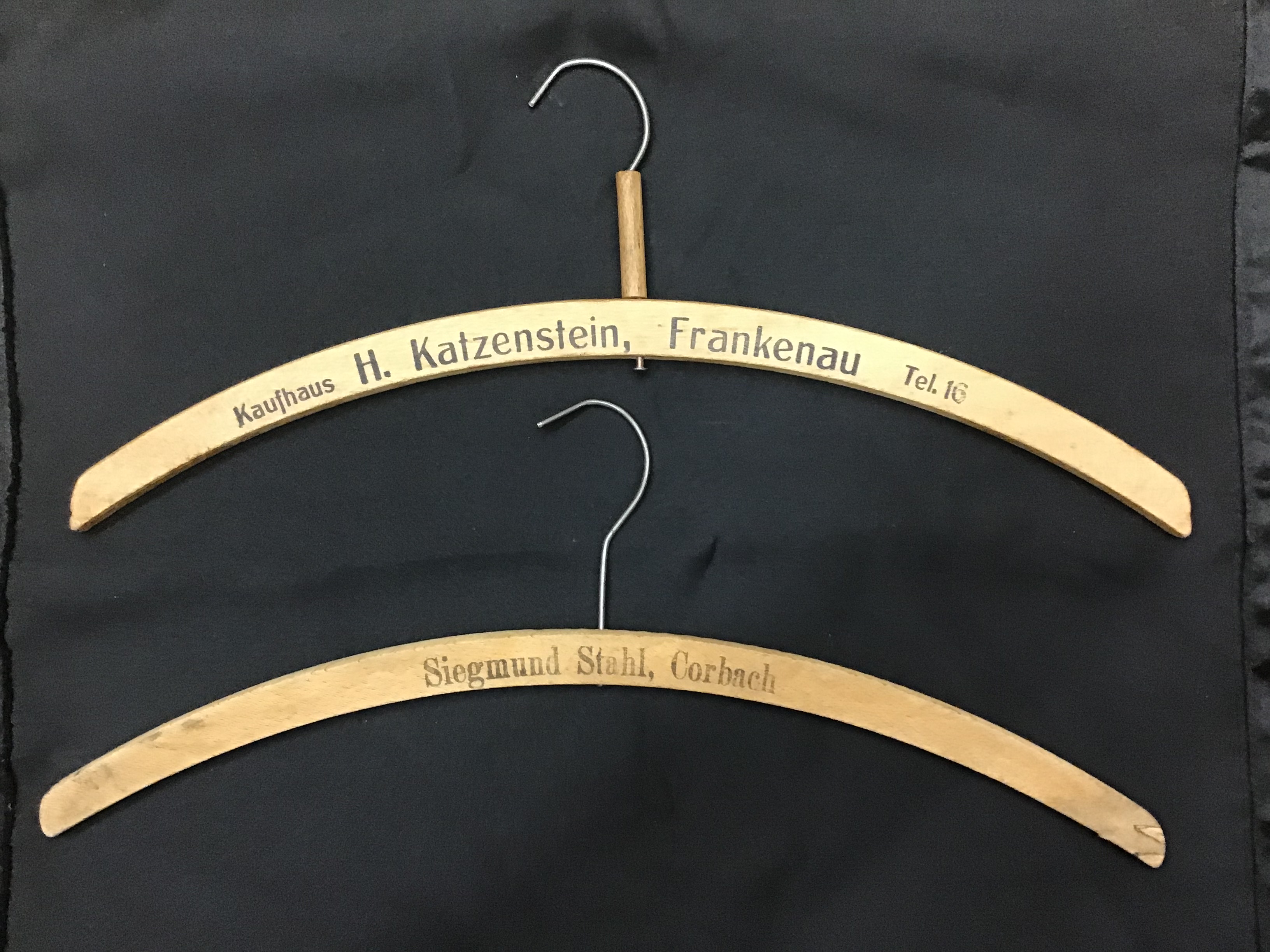 |
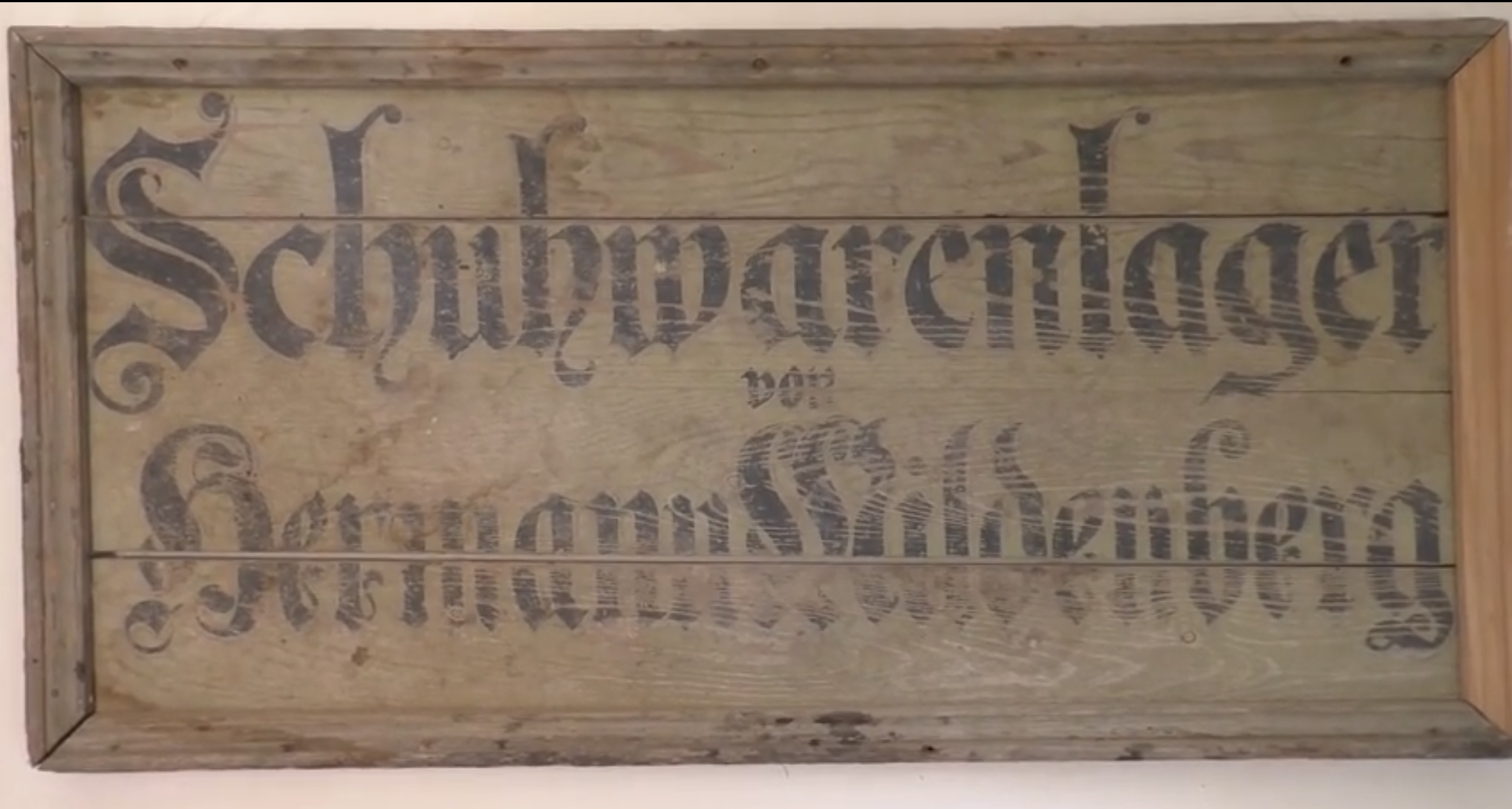 |
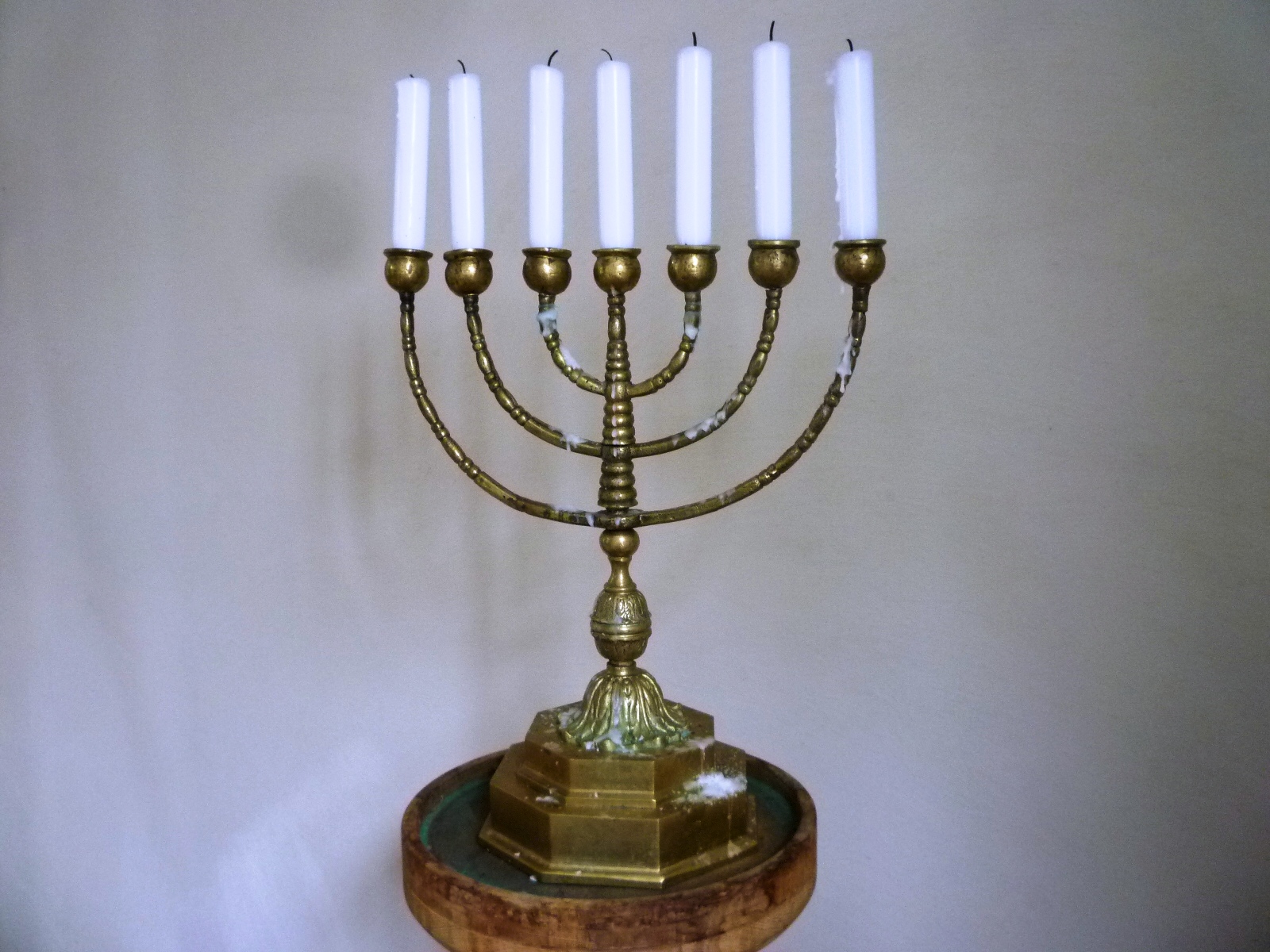 |
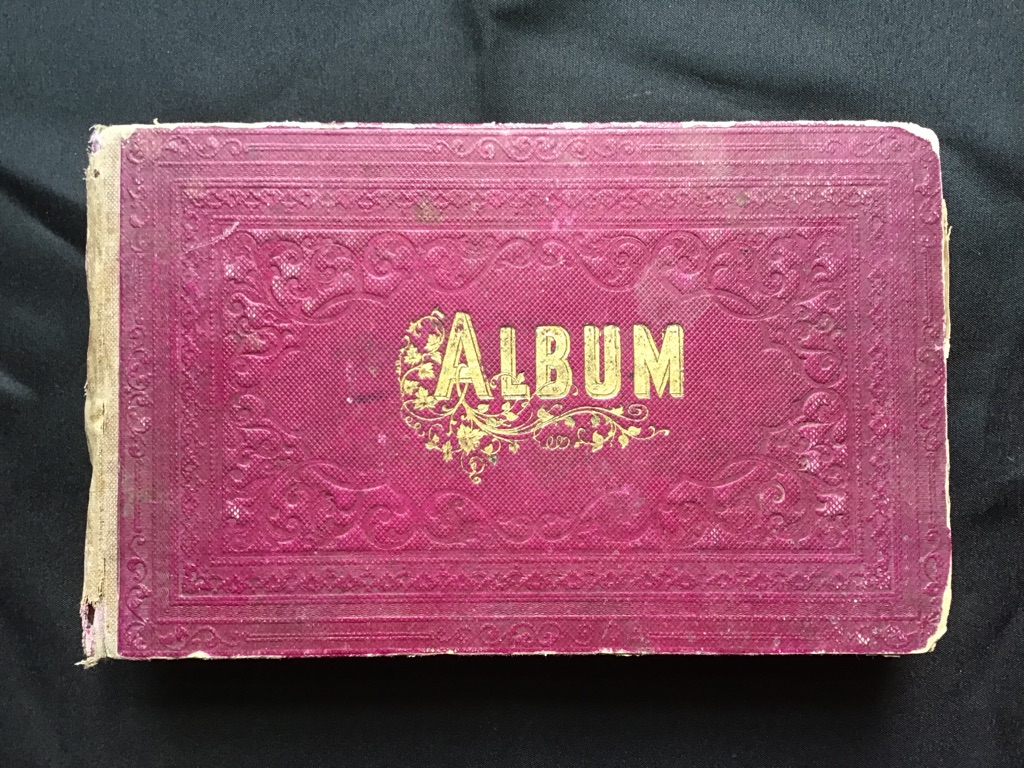 |
 |
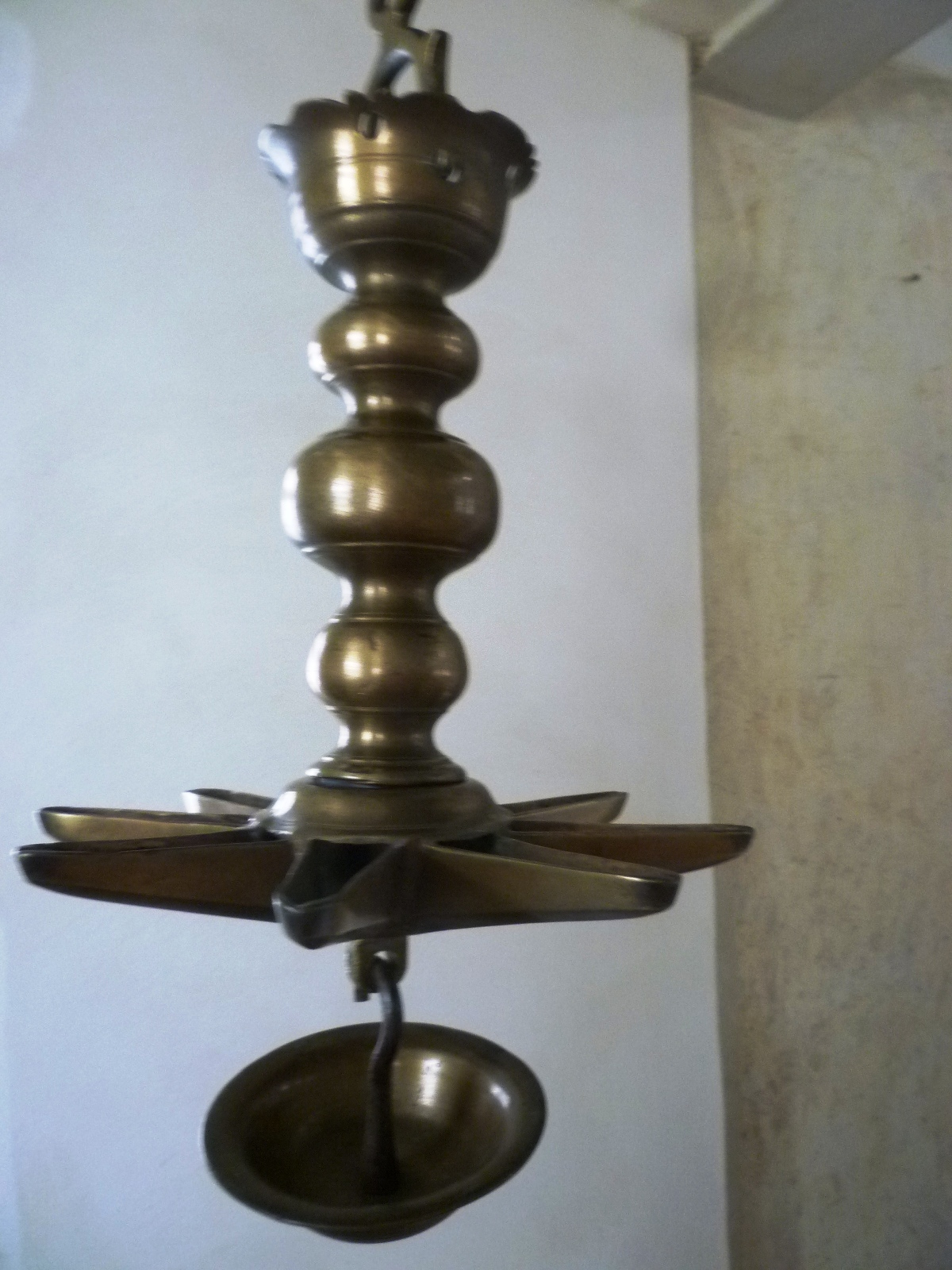 |
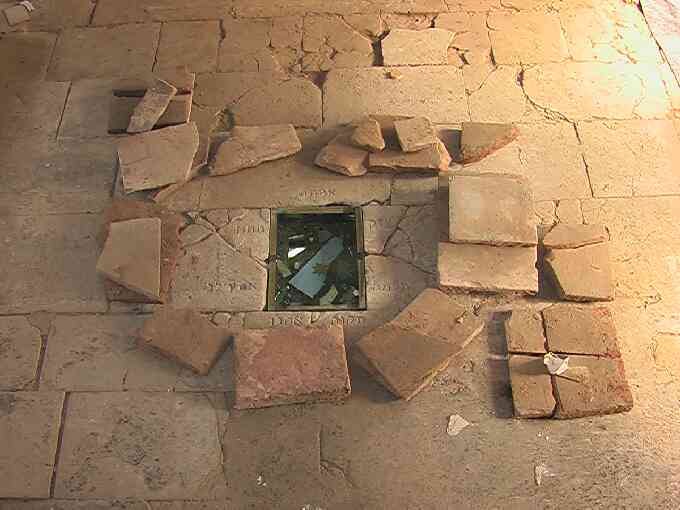 |
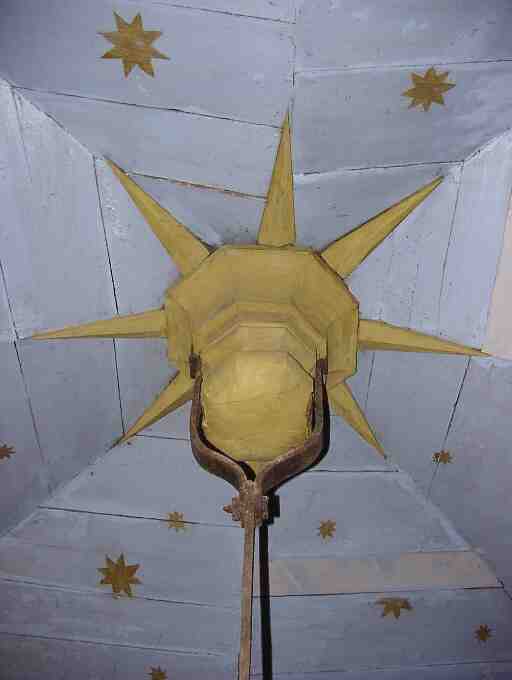 |
 |
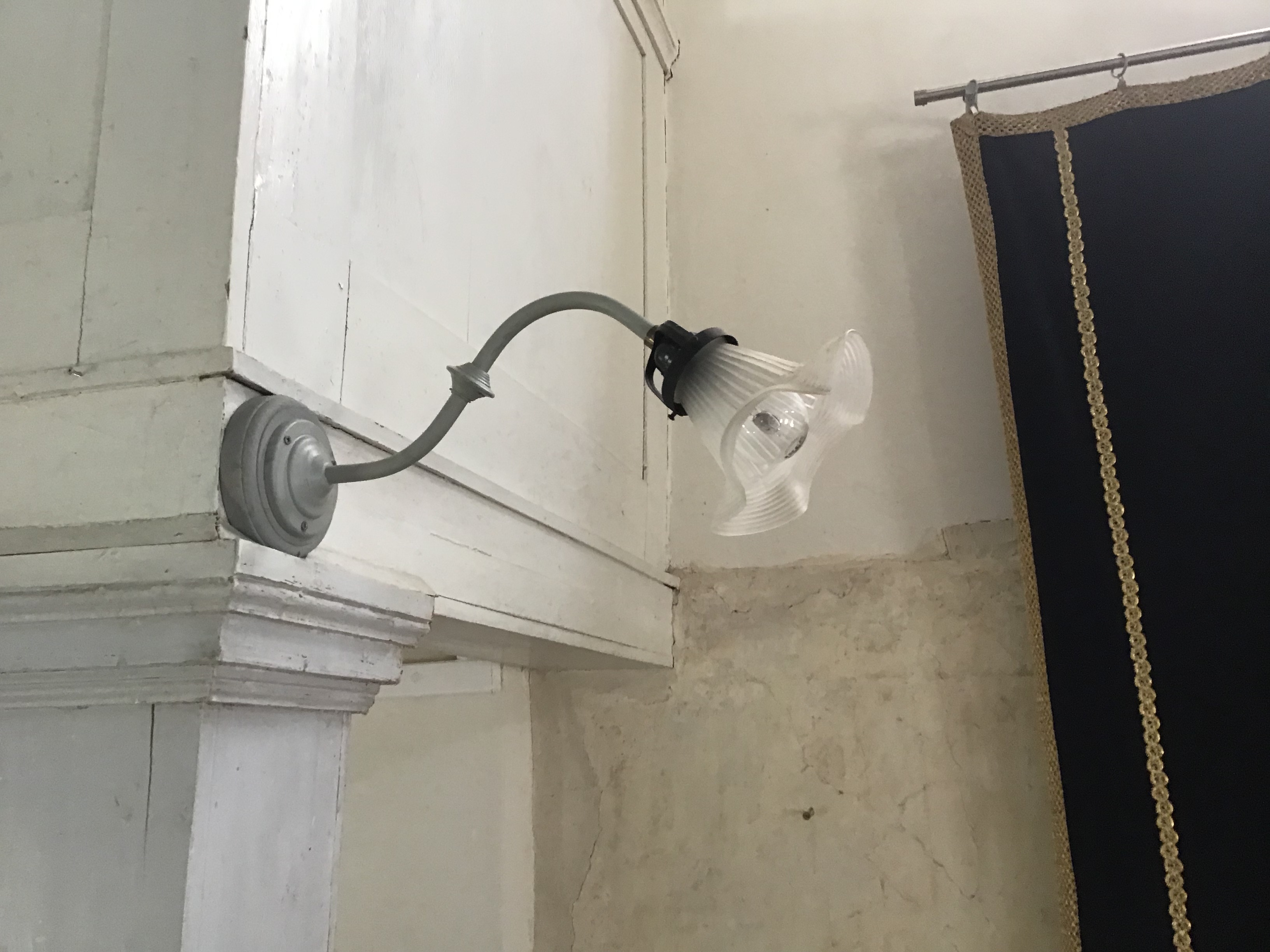 |
From the outside, the entire building has been completely repainted. In the sacred space, however, the dome, the gallery and parts of the sandstone floor have been preserved. Remains of the wall painting can be found above the entrance door. The mural is preserved behind the location of the Torah shrine. This gives an idea of the atmosphere of the Jewish prayer room in the sacred space.
The other exhibits are either of contemporary origin or of unknown age. They can illustrate the former Jewish life in Vöhl.
Descriptions of the exhibits by Karl-Heinz Stadtler. Translation with the help of deepl.
List of exhibits
- Besamim can
- Candle wall holder
- Ceiling chandelier
- Clothes hangers
- Colour findings
- Ester roll
- Foundation stone
- Geniza
- Hanukkiah
- Hawdala candle
- Homage inscription on supraporte
- Homage plaque to Ludwig I.
- Inschrift am Pfeiler und Nagel (2)
- Installation E.R. Nele, ‘They walked upright...’
- Jad (EN)
- Jewish calendar
- Kiddush cup
- Kippa (EN)
- Mappa / Torah pennant
- Menorah
- Mezuzah
- Old photos
- Passover book
- Poems and Writings collected by Selma Rothschild
- Postcard ´Gruss aus Vöhl´
- Qumran-roll (replica)
- Radio set
- Sabbath lamp
- Seder plate
- Shofar horn
- Shop sign
- Siddur (EN)
- Stone flooring
- Synagogue benches
- Tachrichim, Shroud
- Tallit / Prayer shawl
- Tanakh
- Tefillin (EN)
- Torah bearer
- Torah curtain
- Torah scroll for the home
- Torah scroll from Witebsk
- Torah scroll from Wroclaw
- Typsetting box with hebrew letters
- Vault with Starry sky
- Wall lights of the Torah shrine
- Wall of the Torah shrine
- Wall plapue and plate
- Women´s gallery
- Wooden hand
- Zedaka box
- Zohar (EN)
- André Stremmel worked with the "Vuforia™" software. -
Only with the help of a smartphone or tablet are digital objects inserted into the real environment and made visible on them together. Only when the smartphone records the sacred space with its camera does the digital furnishing become visible on the screen. Otherwise not.
They all lived among us
by Karl-Heinz Stadtler
Last update: December 2008
List of Jews in the community (of the modern-day district) of Waldeck-Frankenberg
Translated by Kimberley Simon
This register about Jews from the Waldeck-Frankenberg district is „in progress“. That means that it is not and will never be complete. For several years I´ve been researching in various archives (e.g. Centrum Judiacum Berlin; The Central Archives for the History of the Jewish People in Jerusalem, The Hessian State Archives (Staatsarchiv Marburg), Archives from different communities in this district, and newspaperarchieves) as well as in regional historical literature. Only a small fraction of these sources could be evaluated and incorperated so far.
read more
These records are certainly also flawed. Not everything that has been written in newspaper or books not even in certificates and official documents is correct. In many cases there was no option to fact check the information. In addition to that people with the same name used to live at the same place at the same time. Therefore, dates and facts could not always be clearly assigned to the right person. Furthermore, communal and district staff were not always as conscientious in the past as they are portrait to be. For example, there were often several spellings of one name; sometimes different birth or marriage dates are found in the files of the same person; tax data were also carried over to the next year without exact inspection.
And there can certainly also be errors due to negligence or mistakes made by the writer of this compilation.
But all these causes are the reason why this register is described as “in progress” in the introductory sentence. Even after it was put online this topic is further researched and changes as well as additions will be made.
If you see any mistakes, corrections or have additional information you would like us to include send a mail to
This compilation is made for the internet- not as a book. A book is a finished product, on the internet there is always the opportunity to easily change and add things.
In in individual cases there is justified interest to delete and or remove information about certain persons the author is more than willing to do so.
In the heading of each biography the places in Waldeck- Frankenberg with which the people are connected to are named. If those places are in bold print they lived there for some time. If those places are in normal print they were either related (spouse; children; etc.) to Jews or only lived there for a short period of time.
Many people have provided valuable help in gathering data and facts:
Jürgen Evers, Christiane Kupski and Günter Maier regarding Jews from Vöhl, Carol Baird (esp. for the Frankenthal and Mildenberg families), Heinrich Figge (for Jews in Höringhausen), Ernst Friedrich Gallenkamp (for Jews in the villages of the Edertal community), Reiner Gasse (for Jewish families from the upper Edertal), Johannes Grödecke (for Bad Wildungen), Norbert Hansen (Alsfeld, for relatives of the Rothschild family), Dr. Horst Hecker (esp. for Jews from the old district of Frankenberg and for Jewish patients of the psychiatric clinic in Haina (monastery)), Roger Herz- Fischler (for the Katzenstein family from Frankenau and for families from the upper Edertal), Gerhard Keute and Walter Zarges (for Jews in Altenlotheim and Frankenau), Monica Kingreen from the Fritz Bauer Institute in Frankfurt, Ernst Klein (for Jews in Volkmarsen), Hans-Peter Klein from Melsungen for various families in northern Hesse, Dr. Marion Lilienthal (for Jews from Korbach), Equardo Oppenheimer (for the Oppenheimer families), Matthew Sichel (for the Kratzenstein families), Karl- Hermann Völker (for the Andorn family from Gemünden).
Excellent support was provided by the International Tracing Service (Internationaler Suchdienst) in Bad Arolsen which gave us available copies of all documents concerning Holocaust victims from communities of the Waldeck- Frankenberg district. Archive manager Udo Jost and Mrs. Margret Schmidt deserve special mention.
We are very grateful to all of them.
All sources can be found under this link: Quellen der Informationen
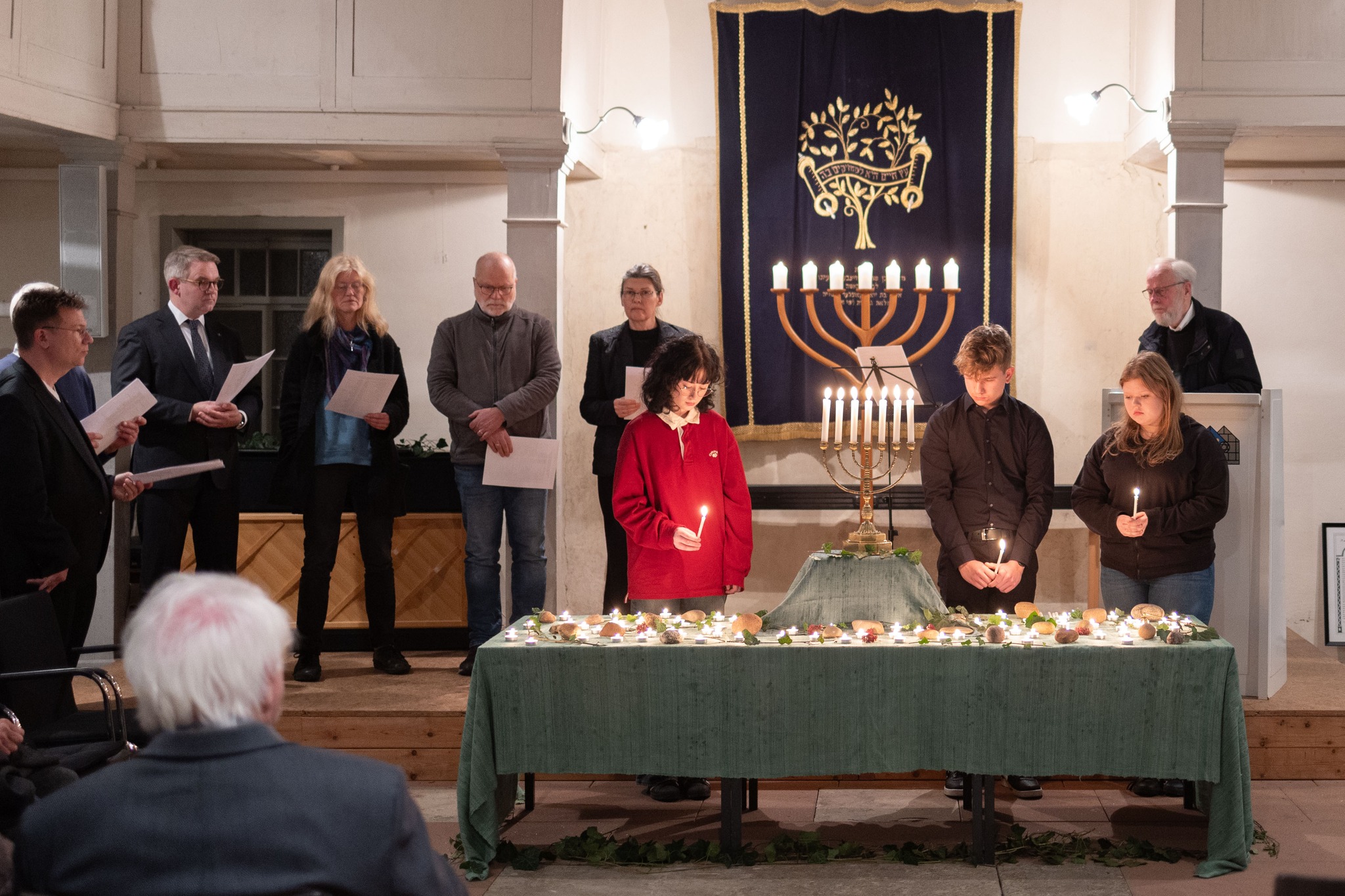
by Karl-Heinz Stadtler
In 1933, 45 Jews were still living in Vöhl and Marienhagen. They gradually moved away. In August 1938, 13 Jews were still living in Vöhl: 3 men, 9 women and a 6-year-old boy. Some of them still moved to Frankfurt, others were deported to Riga, Sobibor, Majdanek and Theresienstadt in 1941 and 1942.
45 women, children and men were killed in the extermination and concentration camps. The names of over 70 people are read out at the annual commemorative ceremonies on 9 November, as the spouses and children of Vöhl Jews are also remembered.
The following is a list of those who were murdered:
Murdered 1933-1945
- Voehler Victims of the Holocaust -
read more
When former Vöhl Jews or their descendants visited Vöhl in September 2000, we promised them that we in the Vöhl synagogue would always remember those people who were murdered in German names. With this directory, too, we are fulfilling our promise.This directory of Vöhl Holocaust victims also includes people who only lived in Vöhl for a very short time, e.g. as employees of merchants. The spouses or children of Vöhl Jews who left Vöhl after their marriage were also accepted.
was born on March 3, 1882 as the daughter of Cäcilie and Samuel Katzenstein in a house in the lower Mittelgasse in Vöhl. In 1901 she married Albert Baruch and moved with him to Essen, where they were born with their two sons Bernhard and Heinz. She died at the age of 60 on 23 August 1942 in Auschwitz, where her son Bernhard Baruch also died a month later, on 23 September.
born on 18 November 1899 in Weener, was employed as a merchant by Ferdinand Kaiser in Vöhl from 1925 to 1927. After their marriage to Paula Meyer from Eimelrod, they lived there, later in Cologne. During the 1930s they emigrated to the Netherlands and lived in Amsterdam. After the occupation of the Netherlands by Germany, they were interned in the Westerbork camp. On 7 September 1943, Max Cossen was deported from Westerbork to Auschwitz with his wife and two children. After arriving on 9 September, Paula Cossen and her daughters Marianne and Lieselotte were killed in the gas chambers. Max Cossen was forced to work for a few more months before he was killed on 31 March 1944.
was born on 18.7.1884 as a child of the Vöhler family Abraham and Frida Blum. In 1906 she married the merchant Adolf Goldblum from Witten and moved to him. The two ran a grocery store there. They were born with their son Heinz. In 1921, Lina Goldblum contributed to the foundation of the Memorial to the Fallen of world war. Lina Goldblum died in Wattenscheid in 1937 at the age of 53.
born on October 25, 1883 in Wolfhagen, was a teacher at the Jewish school in Vöhl from 1907 to 1914. In 1913 he was one of the founders of a shooting club in Vöhl. In 1914 he became a middle school teacher in Frankfurt. Immediately after the beginning of the war he was moved in and he was taken prisoner of war in the Vosges, from which he was released only four years later. Until 1935 he taught at the Brüder-Grimm-Schule in Frankfurt, then until October 1941 in educational institutions for Jewish children. In connection with the pogrom night, he was sent to the Buchenwald concentration camp for six weeks at the end of 1938. In October 1941, he was deported to Lodz along with 1,000 other Frankfurt Jews, including his wife and one of his two sons. There he died of exhaustion in early 1942, according to witnesses.
His wife Jenny Flörsheim was gassed a little later in the nearby extermination camp Chelmno.
Son Kurt Flörsheim was only taken to Auschwitz when the ghetto was evacuated from Lodz in mid-1944, worked in the so-called Sonderkommando and was then probably killed.
Johanna and Bernhard Frankenthal's daughter Beate was born on 7 June 1892. She was considered a very reserved woman in the village and remained single. Beate Frankenthal was deported to Kassel at the end of May 1942 and from there on Tuesday, June 1, to the east. Probably on June 3, the train arrived in Lublin. The working men had to get off there and were driven to Majdanek, while the train continued with the women, children and old men, probably also with Beate Frankenthal, to Sobibor. They were probably gassed there within 2 hours of their arrival. She had turned fifty. However, her name is listed in the memorial book of the Majdanek camp. She may have died there.
was born on September 6, 1887 in Vöhl, the daughter of the Vöhler merchant Hermann Hirsch Frankenthal and his wife Emma. In several eyewitness accounts, she is described as a caring and helpful woman. After her father's early death, she continued to run his business on a small scale. She lived in a small house on Arolser Straße. Shortly after the death of her mother in the spring of 1940, she moved to Frankfurt. Berta Frankenthal was deported from Frankfurt to Kaunas in November 1941 and shot there together with nearly 3,000 Jews from Berlin, Munich and Frankfurt. She was 54.
Johanna Frankenthal, née Bachrach
Johanna Frankenthal was born on 7 July 1868 in Langenschwarz near Hünfeld as the daughter of Jakob and Marianne Bachrach and married Bernhard Frankenthal in 1891. The couple lived with their daughters Beata and Ida on the Schulberg. In the early morning of September 6, 1942, she was picked up from her house by the mayor and another leading Member of the Nazi Party and taken to Itter station. From there she was deported via Kassel on 7 September to Theresienstadt, where she died on 18 November 1942. She was 74.
was born on 2.1.1882 in Korbach. She married Maximilian Hirsch and moved to Sachsenhausen. The children Bernhard, Hildegard and Else were born to them. In 1934 her husband died and she moved back to Korbach. At the end of September 1939 she lived with her sister Hermine Rothschild in Vöhl for a few weeks, probably to help her after the death of her husband Alfred Rothschild, and then moved back to Korbach. On June 1, 1942, she was deported from Kassel via Lublin to Sobibor, where she probably died on June 3 in a gas chamber.
comes from the old Vöhler Blum family, who have been living at least since 1705. She was born in 1890 as the daughter of the merchants Abraham and Frida Blum. Her last known place of residence is the Latvian capital Riga, where she was probably killed in the early 1940s.
was born on 22 March 1890 in Vöhl as the daughter of the Jewish teacher Joseph Laser and his wife Bertha. After the death of her father in 1907, she moved to Kassel with her mother. In 1931, she married the plumber Justus Jacobs and moved with him to Gelsenkirchen. She was "evacuated" from there to Riga in January 1942. She died in Auschwitz on 5 November 1943.
Friederike Katzenstein, née Jakob
called Rickchen, was born on 24 June 1870 as the daughter of Michel and Jettchen Jakob in Sachsenhausen. In 1906, she initially came to Vöhl as a housemaid to the recently widowed Samuel Katzenstein and married the now 76-year-old man a few months later. After his death, she continued to run the business, a colonial goods shop, on her own. On 6 September 1942, she was taken out of the house by two men at four o'clock in the morning and left Vöhl with the things she could pack in a rucksack. A contemporary witness told how she saw little Rickchen Katzenstein walking along Basdorfer Straße with the rucksack on her back between two large men. She was deported from Itter station to Kassel and from there to Theresienstadt on 7 September. She died there on 19 September 1942 at the age of 72.
Gustav Lorsch
was born on August 24th, 1894 in Alsfeld. From 1911 to 1912 he worked as a clerk in Vöhl in Abraham Blum's shop. Later he lived in Giessen. During the war he disappeared somewhere in Poland. His wife Selma, née Stiefel (born 1898) and his sons Arno (born 1927) and Norbert (born 1928) were also deported to Poland in 1942; the latter two are known to have been murdered in Treblinka.
Ferdinand Kaiser
was born on January 10, 1866. His parents Levi and Selka Kaiser moved from Basdorf to Vöhl in the middle of the 19th century. Ferdinand Kaiser, father of four children, owned the "Kaiser Café" in Korbach from 1908 to 1912 together with a partner. However, he lived in Vöhl, where he also ran a shop for manufactured goods, regional products and artificial fertilizers. At the beginning of the century he was a member of the municipal council and the road commission and exercised the function of an honorary lay judge at the court. Ferdinand Kaiser was one of the founders of the war memorial for those who fell in World War I. In 1935 he sold his business in Vöhl and in 1936 moved to live with relatives in Frankfurt. On August 19, 1942, he and his wife Ida were deported from Frankfurt to Theresienstadt, where he died on December 20, 1943 at the age of almost 78.
Ida Kaiser, née Löwenstern
was born in 1869 as the daughter of Bernhard and Bertha Löwenstern in Korbach. At the beginning of February she married Ferdinand Kaiser, who had been widowed two years earlier, moved to live with him in Vöhl and gave birth to the children Anna Bertha and Erich. She also raised the stepchildren Brunhilde and Leopold. Ida Kaiser left Vöhl with her husband in 1936; they moved to live with relatives in Frankfurt. On August 19, 1942, she and her husband were deported from Frankfurt to Theresienstadt. There she died on March 17, 1943 at the age of 74.
Dina Kratzenstein, née Strauss
was born on April 14, 1867 as the daughter of a Strauss family in Eimelrod. After the wedding with the Marienhagen innkeeper, businessman and farmer Felix (Selig) Kratzenstein, she lived with him in the building that is now known as the “old country school home”. They had four children: Hermann, Hedwig, Herda and Julius. In January 1936 she emigrated to Holland with the family of her daughter Hedwig. On April 27, 1943 she was deported from the Dutch transit camp Westerbork to Auschwitz, where she was probably gassed as soon as she arrived. She was 76 years old.
Hermann Kratzenstein
was born on February 5, 1891 in Marienhagen. Right at the beginning of World War I, he was awarded the Iron Cross for bravery in the face of the enemy. In 1918 he married Emilie, née Wertheim, and moved to live with her in Niedermarsberg. The couple had three children: Erich, Ilse and Hilde. Even before the war began, they moved to the Netherlands and lived in Enschede. On April 21, 1943, Hermann and Emilie Kratzenstein were deported to Theresienstadt. The children Ilse and Erich followed on January 20, 1944. On September 28, 1944, the family was torn apart again: Hermann Kratzenstein and son Erich had to go to Auschwitz. A week later, on October 4th, Emilie Kratzenstein and daughter Ilse followed to the extermination camp. Emilie Kratzenstein (50 years old) and probably daughter Ilse (23) were killed in the gas chambers immediately upon arrival.On October 22, 1944, Hermann Kratzenstein was transferred to the Leitmeritz command of the Flossenbürg concentration camp, where he died on January 27, 1945 at the age of 53. Two months after the father, the 17-year-old son Erich Kratzenstein died on March 21, 1945 in the Flossenbürg concentration camp.The daughter Hilde, who was married in the Netherlands, had also been deported to Auschwitz and was taken to the block for medical experiments in the main camp. She survived after an odyssey through several other camps.
Antonie Kugelmann
called Toni, was born on February 5, 1886 as the daughter of Isaak and Sara Kugelmann. She grew up with her four siblings in a house on Kirchweg. In Frankfurt she learned the trade of a tailor and worked as a housekeeper. In 1921 she was one of the founders of the Memorial for the Fallen in World War I at Maßloh, which she felt obliged to do mainly because her brother Max had died in this war. In the mid-thirties she lived in Cologne. There has been no evidence of her since her deportation to Lodz. She may have been around 55 years old.
Ruth Katzenstein, née Mildenberg, then Kugelmann
was born on December 8, 1911 as a child of Moritz and Helene Mildenberg in Vöhl. After the parents' divorce, the mother had taken her maiden name again and probably passed it on to her two daughters. Ruth married Helmut Katzenstein and lived with him and their son Robert in Amsterdam during the war. On August 31, 1943, she was deported from Westerbork to Auschwitz with her husband and son and more than 1,000 Jews. She died on September 3, 1943 in Auschwitz at the age of 32. Son Robert Katzenstein, just 3 years old, died with her. Husband Helmut Katzenstein was referred to the other side during the selection process, worked for six months and died at the age of 33 on March 31, 1944.
Helene Kugelmann
was born on October 8, 1888 in Korbach. In 1911 she married the butcher Moritz Katzenstein from Vöhl and moved in with him. They had two daughters, Ruth and Else. In 1924 they got divorced. Helene Mildenberg moved with her daughters to Korbach and took her maiden name again. In the 1930s she emigrated to the Netherlands with her daughter Ruth Katzenstein and her family and lived with them in Amsterdam. In 1938 she visited her daughter Else in Palestine, perhaps to see her grandson Dimor. Unfortunately, she didn't stay there, but traveled back to the Netherlands. On September 21, 1943, she and 978 other Jews were deported from Westerbork to Auschwitz. Immediately after the train arrived, she died in the gas chambers on September 23, 1943. It was just before her 55th birthday.
Helene Külsheimer
was on 15.2. Born in Basdorf in 1874 as the daughter of the dealer Bendix and his wife Rosa Külsheimer, where she lived with her five siblings. There is evidence that the Külsheimer family lived there before 1800. Helene Külsheimer then lived in Bad Wildungen and from the mid-30s in Kassel. On September 7, 1942, she was deported to Theresienstadt, where she slept in an attic for five months and was given bread and potatoes to eat from time to time. She died there in January 1943 of dysentery and typhus. A rabbi gave the funeral speech for 50 dead at the same time. She was buried in a beautiful linen cloth, as a friend wrote to the relatives in Palestine
Leopold Laser
was born on February 29, 1884 as the son of the Jewish teacher Joseph Laser and his first wife Karoline in Vöhl, where he grew up with his six siblings. The Lasers lived in the large house on Arolser Strasse that Ascher Rothschild had built and which also housed the Jewish school. Leopold Laser was an apprentice at Eisenach, then also worked in Bochum and Hüsten and married Else Goldberg. He last lived with her in Hagen. On March 2, he was deported to Auschwitz together with his wife Else-Eva, née Goldberg, and their son Heinz-Egon. Since they are not mentioned in the files there, it can be assumed that all three of them were gassed and cremated as soon as they arrived. Leopold and Else-Eva Laser were 59, Heinz-Egon was 18 years old.
Markus Lazarus
was born on June 18, 1867 in Oberwerba as the son of Hirsch and Schönchen Lazarus. Around 1890 he married Minna Rosenbaum, moved with her to Vöhl and lived in a house in the neighborhood of what would later become the Fleck house. Two children were born to them, the second of whom died after a few days. Around 1900 he married Minna Müller from Herleshausen. In 1901 their son Sally was born. From 1905 they lived in Kassel. On September 7, 1942, Markus and Minna Lazarus were deported from there to Theresienstadt. Markus Lazarus died there on May 4, 1943, his wife Minna Lazarus, née Müller, six weeks later on June 19, 1943. Son Sally Lazarus died on February 25, 1945 in the Mauthausen concentration camp.
Minna Lazarus
was on 8.2. Born in Oberwerba in 1879 as the daughter of Hirsch and Schönchen Lazarus and moved with them to Vöhl, where she grew up. From 1915 she lived in Kassel; from there she was deported to the Riga ghetto on December 9, 1941. There her trail was lost.
Ludwig Meyer
Born on October 17, 1912 in Bremke, son of the Jewish teacher Louis Meyer and his wife Paula, lived with his family between 1914 and 1926 in Vöhl, then in Korbach. According to the brother, he was a victim of the Holocaust. Nothing is known about the time and place of death.
Minna Meyer, née Kaiser
was born on October 29, 1864 in Vöhl as the daughter of Levi and Selka Kaiser. She was the sister of the Vöhl merchant Ferdinand Kaiser. In 1889 she married Meier Meyer and lived with him in Bremen. On November 8, 1941, she and 1,000 other Jews were deported from Hamburg to Minsk, where she probably did not live long due to her advanced age.
Jenny Mildenberg
was born on May 6, 1887 in Wohnbach, Friedberg district, and was the first wife of Max Mildenberg (the elder). With him she had the son Leo. She separated from her husband and lived with her son mostly in Bad Mergentheim. In July 1942 she was deported to Auschwitz.
Max Mildenberg
was born on January 6, 1902 to Salomon and Amalie Mildenberg. He spent his youth with his sister Rosalie in the house at 7 Mittelgasse, next to the synagogue. Among other things, he was a member of the sports and choral clubs as a teenager. In December 1930 he married the evangelical midwife Marie Luise Thomas. The following year their daughter Gisela was born.Max Mildenberg ran a general store initially for a short time in Henkelstrasse, then in what is now Mittelgasse, first in house number 15, then in number 5; Most recently he worked for the Rohde company in road construction and lived in his parents' house (Mittelgasse 7).On November 10, 1938, he was arrested by three police and NSDAP representatives from Vöhl and deported to Buchenwald via Kassel. As inmate No. 25388 he lived there in Block 4a until March 1939. One of the employees of the concentration camp, as he later told us at home, was a young Vöhler. He was released on February 7, 1939, on condition that he had to leave Germany within a year and after his family had presented an immigration permit for the Dominican Republic and paid a large sum to the Kassel SS. Max Mildenberg left Vöhl and went to Brussels via Remscheid and Cologne. He wanted to catch up with his wife and child, but this was no longer possible because of the start of the war. After the beginning of the "western campaign" in the spring of 1940, he was first interned in the Le Vigean camp in central France, then transferred to Saint Cyprien (on the Mediterranean Sea, near the Spanish border) 74th labor column deployed in the arsenal of Roanne on the Loire. In August he was interned in this column in Fort Chapoly on the western outskirts of Lyon. From there he was taken to the Drancy transit camp northeast of Paris.On September 2, 1942, he was deported by train from Drancy near Paris to Auschwitz, where he was probably killed in the gas chambers of the so-called White Bunker on September 4, as soon as the train arrived.
Minna Mildenberg, née Spier
was born in Allendorf an der Lumda in 1893. She was the first wife of the butcher Albert Mildenberg from Vöhl, had a daughter Margot with him and they lived in Frankfurt. When he emigrated, she did not want to accompany him. As a domestic worker, she lived in Mainz with her daughter Margot Mildenberg, who was also a domestic worker. They were initially concentrated in a regional assembly camp in Mainz, then in the central assembly camp of the People's State of Hesse in Darmstadt, and on March 25, 1942, along with 1,000 other people, were deported to the Piaski ghetto in the Lublin region. Unless they perished there in the following weeks from illness, hunger etc. or were shot during "actions" in the local cemetery, you could have been the victim of the deportation of a large part of the ghetto inhabitants to the Sobibor extermination camp at the end of June 1942, where the most of them were gassed shortly after their arrival. There is not a single survivor of this deportation.
Sophie Nussbaum, née Frankenthal
was born on June 17, 1889 in Vöhl. In 1912 she married the merchant Emanuel Mendel Nussbaum and had with him the son Joseph and the daughter Siddi. In 1921 she made a contribution to the erection of the war memorial for those who fell in World War I on the Maßloh. The Nussbaums lived in the Hünfeld district and later moved to Frankfurt. Together with her husband, she was deported to Theresienstadt on September 16, 1942, and from there to Auschwitz on January 23, 1943, where she was probably killed. Her husband Emanuel Nussbaum died on December 23, 1942 in Theresienstadt. She was 53 and he was 61 years old.
Harry Karl Plaut
,Husband of Klara Külsheimer from Basdorf, lived with his wife in Duisburg before he was deported to Izbica in April 1942. Most likely he died that same year either in Izbiza or in one of the nearby extermination camps Belzec, Majdanek or Sobibor.
Alfred Rothschild
was born on October 4, 1871 in Vöhl as the son of Moritz and Karoline Rothschild, whose Vöhl family tree goes back at least to 1705. In 1904 he married Hermine Katz in Korbach. A year later son Richard was born, who emigrated to Israel in 1935 after a short apprenticeship in the Hachschara (preparatory camp) Grüsen. Alfred Rothschild received the Iron Cross in the First World War, which he often attached to his chest in the 1930s when he was out and about in the village.Alfred Rothschild owned the “Prinz Wilhelm” inn with an attached grocery store. In the 1920s and early 30s he was the director of the amateur theater group and an elected member of the Vöhl municipal council. In the local elections in March 1933, he ran for the local council, but was no longer elected.On the night of November 10th to 11th, 1938, he was arrested and deported to the Buchenwald concentration camp via Kassel. One week after his return in early September 1939, he died on September 13 at the age of 67 as a result of the effects of the concentration camp treatment in his brother-in-law's house in Korbach.
Hermine Rothschild, née Katz
was born on August 4th, 1877 as the daughter of the Korbach grain trader Salomon Katz and his wife Johanna and lived with her husband Alfred in Vöhl after their wedding. Together they ran the “Prinz Wilhelm” hotel. She is said to have been a very good cook. After the hotel was aryanized and Alfred's death, she rented a house on Henkelstrasse.She disappeared from Vöhl on May 29, 1942. On June 1st she was deported from Kassel via Lublin to Sobibor, where she probably died in a gas chamber on June 3rd. Sister Emma and brother Siegfried belonged to the same transport.
Selma Rothschild
was born on February 10, 1867 as the daughter of Moritz and Karoline Rothschild and was the older sister of Alfred Rothschild. Until she was deported, she lived on the top floor of the house built by her grandfather Ascher on Arolser Strasse. At the beginning of September 1942 she was taken from her apartment, on September 6th from Itter train station to Kassel and then to Theresienstadt. On September 29, she was taken to the Treblinka extermination camp together with 2,000 Jews and gassed there on October 1 or 2, 1942.
Mathilde Scharff, née Nussbaum
,born on April 22nd in Niederaula, worked from June 1910 as a so-called support in the household with businessman Ferdinand Kaiser.During the war she was deported to an unknown destination. Where and when she died is unknown.
Bertha Schiff, née Hirsch
Born on August 5, 1875 in the province of Posen, came to Vöhl with her husband at the end of the 19th century and lived here in a house that was demolished many years ago at the intersection of Arolser Str./Schulberg. In 1912 she moved to Korbach with her husband. On July 15, 1942, she was brought to Kassel. On September 7, 1942 she came to Theresienstadt, where she died on May 6, 1944 at the age of 69.
Ernst Schönhof
was born on June 23, 1864 in Vöhl as the son of Jacob and Rosalie Schönhof. He lived in Hamburg with his wife Bertha, née Oestreicher. On August 18, 1942, his wife was deported from Frankfurt to Theresienstadt. Berta Schönhof died there on September 21, 1942. On September 27, Ernst Schönhof was also brought from Darmstadt to Theresienstadt. He died there on November 2nd as a result of the catastrophic living conditions.
Louis Schonthal
was born on April 1, 1895 in Marienhagen as the son of Moses and Regine Schönthal. In 1925 he married Rosa Löwenstein from Affoldern. In 1927 their daughter Ilse was born to them. They lived in Marienhagen, first in house number 50, which burned down in 1928 as a result of a lightning strike, then in house number 35 on Hauptstrasse. Louis Schönthal was a trader by profession. In 1937 he moved to Herford with his family. In December 1941 they were deported to Riga. Louis Schönthal is said to have been killed by a shot in the neck while punishing.
Rosa Schönthal, née Löwenstein
called Alma, was born on December 13th, 1902 in Affoldern. After her marriage she moved to her husband Louis in Marienhagen, in 1937 to Herford. Together with their 14-year-old daughter, the Schönthals were deported to the east in December 1941. Around the turn of the year 1941/42, according to other information in 1944, she is said to have been shot together with her daughter.
Ilse Schonthal
was born on November 15, 1927 as the daughter of Louis and Rosa Schönthal in Marienhagen. In 1937 she moved with them to Herford, and in December 1941 the 14-year-old was deported to the east with her parents. A book about the Herford Jews reports that Ilse Schönthal died when she threw herself into her mother's arms to protect her and was shot with her.
was born on June 22nd, 1869 as the son of David and Bertha Stern and lived in Vöhl. He and his sister owned houses 1 and 3 in Mittelgasse, where they ran a shop. In the mid-thirties, the siblings sold the Vöhler houses and moved to Frankfurt. On September 15, 1942, Albert Stern and his sister Rosalie were taken to Theresienstadt. Albert died at the age of 73 in October 1942 in Theresienstadt.
Rosalie Stern
Born on September 22, 1866, was Albert Stern's older sister. Both remained unmarried and lived very withdrawn. Her ancestors had lived in Vöhl since at least 1705. In the mid-30s they sold their houses and moved to Frankfurt. Rosalie Stern died at the age of 77 on February 18, 1943 in the Theresienstadt concentration camp.
Rosalie Sternberg, née Mildenberg
was born in 1904 as the daughter of the merchant Salomon and his wife Amalie Mildenberg in Vöhl. In May 1931 she married the merchant Martin Sternberg from Katzenfurt near Wetzlar in the Vöhl synagogue. In 1932 their son Günter Siegfried was born to them. During the Third Reich they stayed in Vöhl and lived in Mittelgasse. In 1938 Rosalie probably wanted to emigrate with her family. Possibly she stayed because her brother Max was deported to Buchenwald. Since Rosalie had contacted Max in the Gurs camp in southern France by letter, she was sentenced to a few weeks in prison in 1941. In the spring of 1942 the family was brought to the assembly camp in Wrexen and from there deported on June 1st to Sobibor, where they were probably killed together with their son shortly after their arrival on June 3rd.
Martin Sternberg
was born on July 18th, 1903 in Katzenfurt near Wetzlar. In May 1931 he moved to Vöhl, where he married Rosalie Mildenberg. In 1932 they had a son. They stayed in Vöhl during the Third Reich. Sternberg was a businessman, but most recently had to work in civil engineering. He was also sentenced to prison in 1941 because of written contacts with his brother-in-law Max in the Gurs concentration camp. In 1942 the family was deported to Wrexen and from there to Lublin on June 1st. There he was separated from his wife and child and taken to Majdanek. After three months of forced labor in the local camp, he died on September 5, 1942.
born on August 20, 1932 in Sachsenhausen, lived as the son of Martin and Rosalie Sternberg in Vöhl. Since Jews were no longer allowed to attend normal school, he had to attend a Jewish school in Frankfurt from 1939 and live in a Jewish orphanage there. In autumn 1941 the children were sent home for the intended deportation. In the spring of 1942 the family was taken to the assembly camp in Wrexen - initially Günter, a few days later also the parents - and from there on June 1st to Sobibor, where he and his mother were probably killed shortly after their arrival.
Bertha Strauss, née Frankenthal
was born on October 19, 1858 as the daughter of Selig and Jettchen Frankenthal in Vöhl, where she grew up with her siblings Hermann, Lina, Bernhard and Julius. In 1889 she married the businessman Jacob Strauss and had several children with him. She emigrated from Germany to Amsterdam, but was deported to the Westerbork camp on March 20, 1943 and from there to Auschwitz on September 7 of the same year, where she was killed on September 10, the same day as her son Hugo Strauss and his wife Ella Strauss, née Reinberg.
Hedwig Winter, née Kratzenstein
was born on February 28, 1895 in Marienhagen as the daughter of the innkeeper and farmer Felix Kratzenstein and his wife Dina. She grew up with three siblings in the so-called “old country school home”. In 1919 she married the cigar maker Max Winter, with whom she had two daughters, Berni and Gertrud. In January 1936 the whole family, including grandmother Dina Kratzenstein, emigrated to Holland. On October 19th In 1942 she was killed in Auschwitz.
Max Winter
was born on September 23, 1889 as the son of the cigar maker Abraham Winter and his wife Bertha in Tortrow, according to another source in Jastrow. In 1919 he married Hedwig Kratzenstein and moved to Marienhagen, where he continued to run his father-in-law's inn. In 1936 the family, which also included their daughters Berni and Gertrud and their mother-in-law Dina, emigrated to Holland. Max Winter was murdered on March 31, 1944; the place is not known.
Berni von Geldern, née Winter
was born on October 16, 1920 as the daughter of Max and Hedwig Winter and lived in Marienhagen in what would later become the "old" school home. In 1936 the family emigrated to Holland. On October 19, 1942, she and her sister were deported to Auschwitz, where they were murdered on October 19, 1942.
Gertrud Winter
was born on 9.6.1924 as the daughter of Max and Hedwig Winter and lived in Marienhagen in what would later become the "old" country school home. In 1936 the family emigrated to Holland. On October 19, 1942, she and her sister were deported to Auschwitz and probably killed in a gas chamber on the same day.
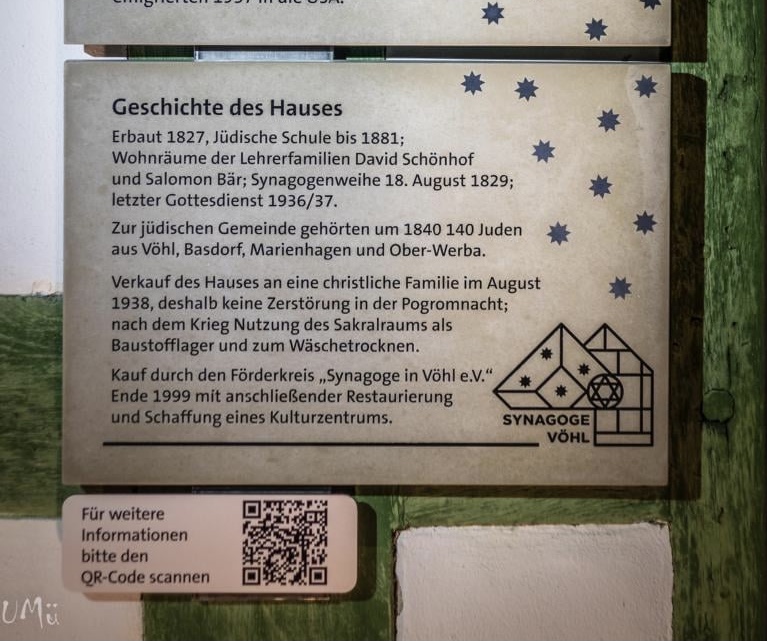
Information board at the Synagogue, Foto: Ulrich Müller
Over the next few years, we want to install information boards on houses in Vöhl with former Jewish residents. The plaques are provided with QR codes that lead to further information about the former residents.
In 2020, we started with the former synagogue at Mittelgasse 9.
In 2022, four more plaques were added near the synagogue: Mittelgasse 1, 7 and 11 and Basdorfer Str. 9.
In 2024, the plaques at Arolser Str. 8 and 13, Schulberg 12, Jewish Cemetery and in Marienhagen, Schulweg 8 will be added.
The Tour of houses formerly inhabited by Jews in Vöhl takes you to the locations.
In the year 2000, the Friends of the Synagogue in Voehl invited former Voehl residents of Jewish faith to the town. The first meeting took place in Café Tassius in Voehl on 6 September 2000 and the introductions were recorded on tape.
The following Jewish persons or their descendants were present in the order in which they were seated:
- Walter Mildenberg (*1921) und Marian Mildenberg, geb. Katz (*1925); USA; siehe: Stammbaum Familie Mildenberg, Levi
- Gisela Frees, geb. Mildenberg (*1931) und Werner Frees; Vöhl; siehe: Stammbaum Familie Mildenberg, Mayer
- Ursula Behrend, geb. Mildenberg (*1924) und Howard Behrend (*1923); USA; siehe: Stammbaum Familie Mildenberg, Levi
- Carol Baird, geb. Davidsohn, her grandmother was Ida D., geb. Frankenthal (*1945) und Stephen Baird (*1944); USA; siehe: Stammbaum Familie Frankenthal, Herz
- Geffroy Baird (*1974), his great-grandmother was Ida Davidsohn., geb. Frankenthal; USA; siehe: Stammbaum Familie Frankenthal, Herz
- Walter Rothschild (*1920) und Sonja Rothschild, geb. Jäger; Argentinien; siehe: Stammbaum Familie Rothschild, Ascher + Sprinz
- Richard Rothschild (*1905) und Gerda Rothschild, geb. Westfeld (*1913); Israel and Germany; siehe: Stammbaum Familie Rothschild, Ascher + Sprinz
- Rudolf Rothschild (*1931) und Sigrid Rothschild, geb. Mayer; Argentinien; siehe: Stammbaum Familie Rothschild, Ascher + Sprinz
Henriette Hennig transcribed the audio recordings in 2018 during her work as a "Landkulturbotin":
Complete transcript of the introductory round
| Kurt-Willi Julius | Förderverein Synagoge in Vöhl |
| Ilse Schenk | Förderverein Synagoge in Vöhl |
| Dr. Ingrid Engelsing | Ärztin in Vöhl |
| Barbara Sahra Küpfer | Förderverein Synagoge in Vöhl |
| Heinz Schäfer | Förderverein Synagoge in Vöhl |
| Anna Evers | Förderverein Synagoge in Vöhl |
| Günter Maier | Pfarrer in Vöhl |
| Claus Hömberg | Architekt der Renovierung |
| Birgit Stadtler | Förderverein Synagoge in Vöhl |
| Sandra Stadtler | Förderverein Synagoge in Vöhl |
| Peter Göbel | Förderverein Synagoge in Vöhl |
| Karl-Heinz Stadtler | Förderverein Synagoge in Vöhl |
{youtube}|370|310|0{/youtube}
This round of visitors was the start of the programme for the
Visit by former Jewish residents in September 2000.
by Karl-Heinz Stadtler 2006
Translated by Kimberley Simon
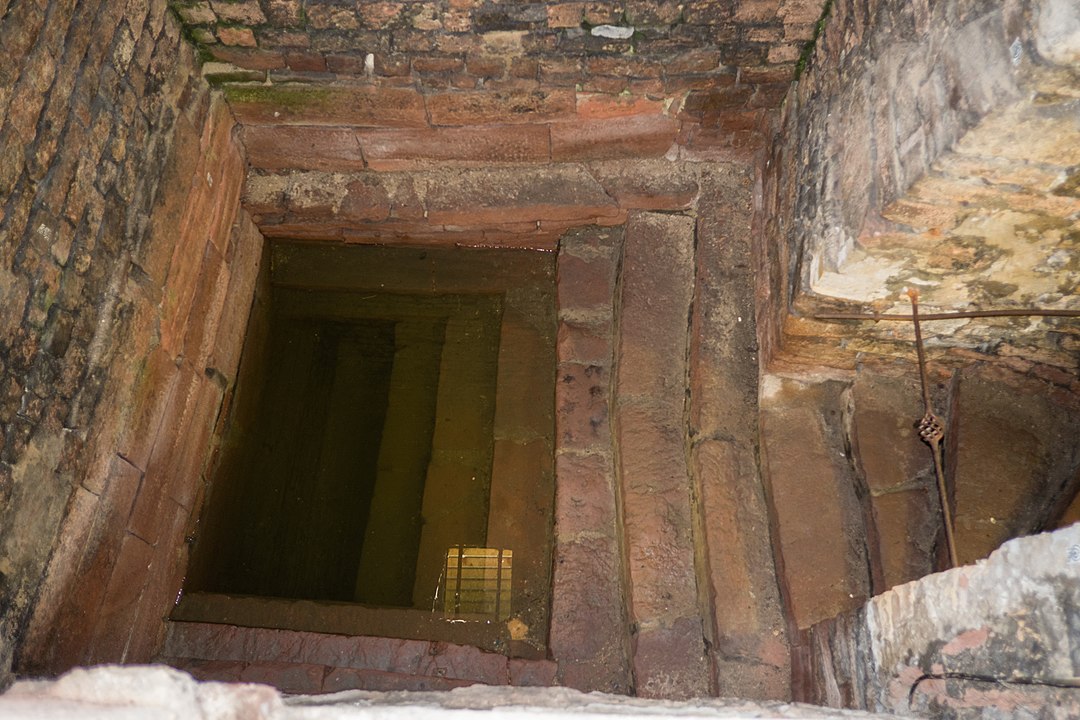
read more
- Suprising find in Volkmarsen
- Water cleanses
- Biblical foundation for the Mikveh
- The occasions for the use of the Mikveh
- Construction and the way it’s used
- The Mikvaot of the Jews in Vöhl, Marienhagen and Basdorf
It was quite a sensation when Ernst Klein, chairman of the association “Rückblende” in Volkmarsen, reported having found an approximately 500-year-old mikvah in a house in the town center of Volkmarsen. He had suspected this for a long time, but now it was proven by excavations and scientific research: In a house built in the 13th century with a very special cellar vault, a shaft mikvah was installed in the 16th century.
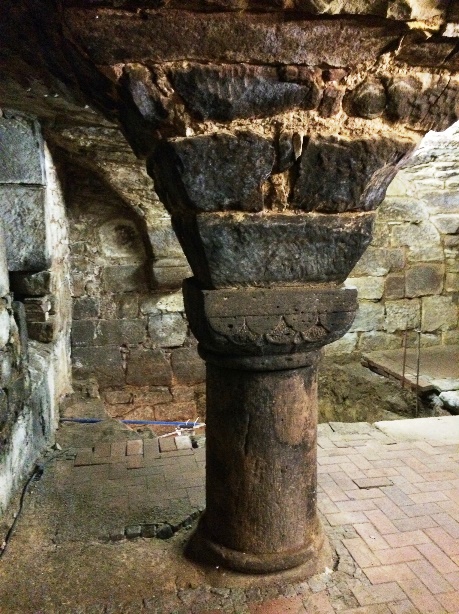 One of the vault columns Photos: Karl-Heinz Stadtler |
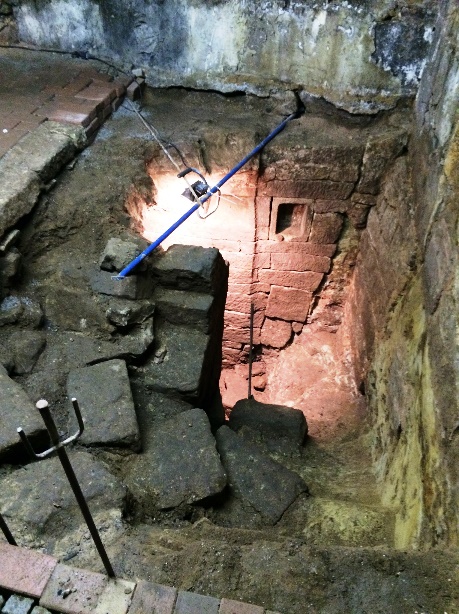 Stairs to the mikveh with shelf |
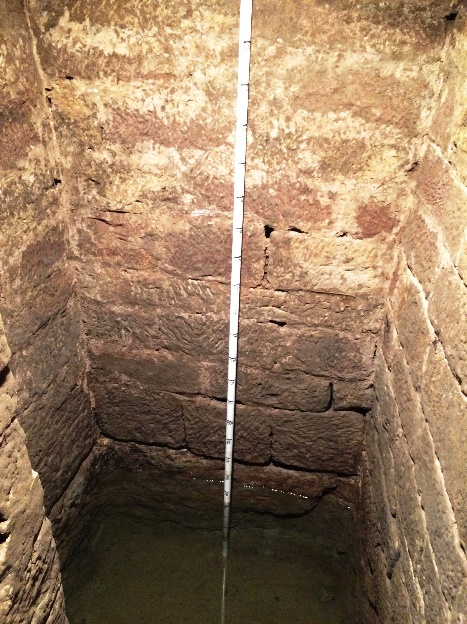 Shaft mikveh in Volkmarsen |
Of course, it was no surprise that there was a mikvah in Volkmarsen. Such a ritual immersion bath was located in the synagogue built in 1827. The special thing was the age of the now found mikvah, because the finding proved that already in the 16th century Jews lived in the city.
But first of all, what is a mikvah?
Water cleanses- literally and figuratively!
Anyone who has worked all day - building a road or a house, in a factory or a repair shop, in a kitchen or a garden, in a stable or in the fields - appreciates a shower in the evening. Even if you didn't get dirty at work, maybe didn't even sweat, you feel fresh and cleansed after a shower or bath.
Wounds are cleaned with water before they can be treated. Surgical instruments or other medical equipment are cleaned before use. The risk of infection is eliminated by using water with appropriate additives.
The cleanliness of the home, of clothing, of rooms where food is produced or sold, of hospitals are criteria of healthy living for us. And despite all chemical or biological additives, the most important cleaning agent is still water.

On the other hand, we are familiar with the television or magazine pictures of thousands of Hindus immerging into the brown and dirty but sacred waters of the Ganges to ritually wash themselves, because the bath is also supposed to cleanse one from the evil done or experienced. This rite was certainly introduced at a time when the water of the river was not yet harmful to people's health.
 Holger.Ellgaard, Skondals kyrka 2005, CC BY-SA 3.0
Holger.Ellgaard, Skondals kyrka 2005, CC BY-SA 3.0
Baptism is also an exclusively ritual cleansing: a handful of water with which the priest strokes the child's head symbolically cleanses from sins and at the same time welcomes the child into the religious community. There are also Christian communities where full body baptism is common or even mandatory.
Ritual cleansing with water is also of great importance in the Jewish religion. It goes back to the books of Moses, where the need for cleansing is emphasized in various places in the Torah. The first passage (Leviticus 14:8) deals with the cleansing of lepers, of whom there were many at that time. There it says in the Holy Bible, New International Version:
- “The person to be cleansed must wash their clothes, shave off all their hair and bathe with water; then they will be ceremonially clean. After this they may come into the camp, but they must stay outside their tent for seven days.
- On the seventh day they must shave off all their hair; they must shave their head, their beard, their eyebrows and the rest of their hair. They must wash their clothes and bathe themselves with water, and they will be clean.”
The 15th chapter of the same book deals with a man's discharge from his genitals, semen that is ejaculated during sleep, and a woman's menstrual cycle: the people involved, as well as everyone with whom they have come in contact with, and also all objects they´ve touched, are considered unclean and require ritual cleansing.
In addition, there is a whole series of other regulations in which cases the mikvah is to be used. Only after that, the attendance at religious services is allowed again. In the 4th Book of Moses in the Holy Bible, God commands to punish those with death who does not keep these purification commandments. The literal translation (Numbers 19:10-13) reads:
“10. This will be a lasting ordinance both for the Israelites and for the foreigners residing among them. 11. Whoever touches a human corpse will be unclean for seven days. 12. They must purify themselves with the water on the third day and on the seventh day; then they will be clean. But if they do not purify themselves on the third and seventh days, they will not be clean. 13. If they fail to purify themselves after touching a human corpse, they defile the Lord’s tabernacle. They must be cut off from Israel. Because the water of cleansing has not been sprinkled on them, they are unclean; their uncleanness remains on them.” Thea Altaras thinks that those translations did not correctly quote the source. In the Jewish version of the text, the sentence has a different meaning.
Since Isaiah, ca 500-400 BC, it is mandatory to wash thoroughly - with soap - before diving into the water, the "pre-washing".
To the Jews who had become pagan, God says through the prophet Ezekiel (36:25) “ I will sprinkle clean water on you, and you will be clean; I will cleanse you from all your impurities and from all your idols.” The prophet Isaiah tells his fellow believers (12:3) “With joy you will draw water from the wells of salvation.”
In the Letter to the Hebrews, the unknown author urges the addressees (10:22): “let us draw near to God with a sincere heart and with the full assurance that faith brings, having our hearts sprinkled to cleanse us from a guilty conscience and having our bodies washed with pure water.” The Christian author of these lines here expresses the cleansing with water still completely in Jewish tradition; the Christians of his generation may still have used the mikvah.
In Germany, the mikvah is often referred to as the "women's bath" because it is mainly visited by women after their menstruation. They are not allowed to have sexual relations until they have "immersed" on the seventh day after the end of their menstrual period. Before that, however, they wash or bathe themselves in order to enter the mikvah with a clean body. Women also use the mikvah before marriage and after childbirth.
Some Orthodox men still follow the old custom of going to the immersion bath before Sabbath and before high holidays.
Dishes are also ritually cleaned in the mikvah: both the dishes that one has just bought new and the dishes that one intends to use for meaty things but which might previously have been used by others for "dairy" things, or vice versa, and finally dishes and other containers or clothing that have come or might have come into contact with animals considered unclean or the remains of unclean or even clean animals.
Items purchased from non-Jews require an immersion bath.
Linen or clothing that has come into contact with impure bodily fluid is also ritually cleansed in the immersion bath.
Originally, there were more occasions for the use of the mikveh.
In the past, the mikvah also had to be used by priests before services. And finally, converts, i.e. people who converted to Judaism from another religion, have to take an immersion bath; in this respect it is somewhat similar to Christian baptism.
It is pointless to ask why ritual cleansing is necessary in all these cases. Sometimes it is argued with health reasons, but then it is implied, firstly, that it was not always exclusively a ritual, but historically also an actual cleansing; and secondly, there are cleansing occasions that cannot be justified medically. Perhaps it is just our mindset, our way of thinking, which demands rational reasons. For devoted Jews it is enough and must be enough that there is a corresponding commandment of God; the question of "why" does not arise then.
Not every Jew uses the immersion bath. As in other religions, Jews are differently religious. Moreover, the question of whether or not a bath in the mikveh is necessary, and in which cases, depends not only on one's personal intensity of faith, but also on which of the many branches of Judaism one belongs to: Is one more Orthodox or more Reform? Does one come from Eastern or Western Europe, from the USA or South America, from Africa or an Asian country? Do you live in regions where water is plentiful or do you live in a desert? Different origins certainly have an influence on whether or not certain rites are observed, and if so, in what way.
What was described at the end of the previous chapter also applies to the structural design and the way in which a mikvah is used, perhaps even more so, because with regard to the occasions for ritual cleansing, one can still refer to the regulations of the Torah, to God's laws. But when it comes to the question of what a mikvah should look like and how men and women should bathe in it, the Torah is of no help. Here there are the rabbis who have discussed and established rules over the centuries - often in discussion and debate with others. There may be common ground that applies to several religious directions, perhaps even to all Jews, but there are also quite significant differences. Not all the statements of the ancient teachers are clear; interpretations are often necessary. Rules are also modified or changed due to changing lifestyles and the development of new building materials. One assumes - rightfully so - that this or that teacher a thousand or even fifteen hundred years ago in Spain or in Central Europe or in the Near East developed his teachings on the basis of the conditions given then and there, that they are not easily transferable to the present and are therefore adaptable. Such adaptations and transmissions are also made today by rabbis in their examination of the ancient texts and in discussion with other scholars and teachers of the faith. Thus, even in the present day, there are differences in terms of the structural design as well as the way in which a ritual bath is used.
The most important written basis for any discussion of this question is the section on the "mikvaot" (plural of mikveh) in the Mishnah, which was compiled around the year 200 based on the work of even older teachers by Rabbi Yehuda and forms the basis of the Talmud. In ten sections, it goes into all the details and deals in particular with the cases in which the immersion bath is ritually invalid.
Incidentally, not every rabbi claims the right to decide on the installation of a mikveh. Thea Altaras, who as a Jewish architect is a specialist in the religion, rites and culture of Judaism, writes in her two books on the ritual immersion bath, published around 1990, that there is currently no one in Germany who is confident enough to decide on questions of the installation of a mikvah. In Giessen, where Mrs Altaras lived and worked, a rabbi from abroad was brought in to avoid mistakes that could, in extreme cases, invalidate the ritual bath. The name of the rabbi responsible is attached to the immersion bath (building plaque) in Giessen. He therefore now also subsequently vouches for a facility that complies with the "Halachah", the Jewish religious laws.
The Hebrew word mikva or mikveh means a collection or damming of water. Natural water - a river, a pond or lake, a sea - or an artificial bath, the water of which has not been scooped with a vessel or reached the immersion tank by human hand, can be used for this purpose. A flowing body of water can only be considered ritually suitable if it contains a quantity of spring water or - perhaps depending on the time of year - at least some rain or melt water; the reader of these lines will realise that even in this case one must "interpret" and "reinterpret" in order to act in accordance with the rite. In the immersion basin, however, only ground water is allowed to "flow", otherwise it must be standing water.
There are very specific requirements for a built mikvah: it must be deep enough to allow complete immersion; according to Kolatch, it must hold at least 762 litres of water and have an inflow of "living" water, i.e. be fed from a spring or a river. Thea Altaras states a minimum capacity of 250 to 800 litres of water, which is enough if the person can be completely submerged in the pool.
She distinguishes between three types of suitable water for a ritual immersion bath: 1. ground or spring water, 2. "accumulating" water, by which she means rainwater or melted snow, and 3. flowing water. Depending on the type of water, the construction of the mikvah varies. It is not necessary to go into detail about this for the purpose of this paper. Those who are interested can read about it in the book by Thea Altaras.
Wherever possible, mikvaot are built near rivers in order to use river water for bathing, especially since the groundwater level is usually higher near rivers or streams. Now and then, however, a deep shaft is dug down to groundwater level in order to be able to build a bath that complies with the rules and the relevant water reservoirs.
 A woman purifies herself in a mikvah, while her husband waits for her in bed. Germnany 1427/28 Photo: public domain |
 Cleaning of dishes in the mikvah. Photo public domain |
The ritual immersion bath requires thorough preparation. Food regulations must be observed, the body must be thoroughly cleaned and all things foreign to the body (rings, even prostheses and hairpins) must be removed. The body is then immersed down to the last tip of the hair, making sure by posture, finger spreading etc. that every part of the body is in contact with the water. Eyes and lips are only slightly closed.
Visitors to the synagogue in Vöhl often ask about the mikveh because they know from other places that this feature is almost always, or at least very often, located in the synagogue building. This applies - as mentioned above - to Giessen; but also in Weimar-Roth, where they restored the former synagogue a few years ago, the mikveh was right next to the building.
In Vöhl it was different. There was never a mikveh in the synagogue. On the basis of historical documents, we can now show how the Jews of our region and the state authorities dealt with the Jewish ritual baths.
A letter from the Grand Ducal Government of Darmstadt dated July 17th, 1813, is the oldest document we have on this subject. It praises Jewish law, which commands women to purify themselves after menstruation or childbirth (the government obviously did not recognise the ritual nature of this purification either), but the law is "misused by the Jews to disturb and undermine the health of the female sex"; the women's bath is usually a deep hole in the cellar of the house with ice-cold spring water, which results in "the most incurable blood flows, emaciations and nerve infections (!)". So the government demanded the construction of warm baths, which did not happen.
Five years later, on June 17th 1818, the physicus (= doctor) Goldmann from Vöhl reported to the government in Gießen about eleven baths in the district of Vöhl, including three in Vöhl itself and one each in Basdorf and Marienhagen. All of them - including those in Höringhausen, Altenlotheim and Eimelrod - were "without exception, very harmful and reprehensible". Then he describes them in more detail:
"They are all in cellars, some vaulted, some low, barely 5 shoes high, damp, dull, with beams, some of which have light, others dirty, very foul-smelling, and cold, nasty spring water, which is constantly open in such a cellar hole, and is polluted by all kinds of things. The bathing women must undress and dress in these cellars, or go naked from a parlour into such a cellar, and from there back into the parlour, where they dress, so that one is surprised that far more of these women do not get ill.
He admits that it is not possible to build "a harmless bath" everywhere, but says regarding Vöhl
"The Jews, of which 8 families live here, are all wealthy, some even very rich, but up until now, although they themselves very much wanted a proper bath, they have not built one of their own because of disharmony; these people must therefore be forced, and then, in my opinion, they will gladly follow the order.
He also proposes similar baths for Höringhausen and Eimelrod. The Jewish women's baths in Marienhagen, Basdorf and Altenlotheim, where the families were too poor to build mikvahs in the way he wanted, were supposed to be closed down and the Jewish women encouraged to visit the baths in Vöhl. "Not only as a physicus, but also as a humanitarian", he asks the government to change the "law, which is considered appropriate, but which in fact has a murderous effect", as he suggested.
Again two years later, the government in Giessen seems to want to become more forceful: On January 15th, 1820, it calls on the Vöhl magistrate to finally do something about the situation. The Jewish community gives in, confirms the hygienic problems regarding the baths through Selig Salomo Rothschild and applies for a new building, which the government approves, but then nothing is done for another four years. In January 1824, the government again requests a status report on the baths, which Vöhl delivers in February. The letter describes the conditions as bad as the physicus' report of 1818, but also comes to the conclusion that at least the "Jews at Altenlotheim, Marienhagen and Basdorf could have new harmless baths, but they would not be able to invest in new healthy ones. Now, however, the government finally wants to see action. In January 1825, it asks Krebs, the district administrator of Vöhl, to begin "burying" the baths within 14 days. The district administrator does not hurry: only after the deadline has expired he addresses this request to the mayors of Vöhl, this time setting a deadline of four days. The mayor reports "that the Jews in the community of Basdorf no longer have any earth baths in front of the Jewish women. Feidel Keiser has a well in the cellar which used to be for this use, but he used it as a well for his family. And the mayor of Marienhagen answers firmly: "... there is no earth bath in Marienhagen."
Although it is difficult to read because of the unfamiliar language, the letter sent to Gießen by Krebs, the district administrator of Vöhl, on February 25th, 1825, is quite interesting:
"As a result of the order above, the mayors were immediately instructed to have all the Jewish earth baths buried. The mayors were immediately ordered to have all Jewish earth baths buried, but complaints were filed from all parts of the city, which led me to withdraw the order. The masters of these baths are not only used as such, but at the same time serve either as wells for the cattle, or in the cellars, where no drain can be installed, to collect the water to a point, and are then also very useful for fires, especially here in Vöhl, where there is a lack of water containers.
However, in order to achieve the purpose intended by this high bull [=law], and at the same time to satisfy the rightful wishes of the bath owners, I have ordered the Jewish community here at Höringhausen and Eimelrod to provide their baths, if they have not buried them, with well casings that make their use as such impossible, and to construct a bath in each of these places (the others Marienhagen, Altlotheim and Basdorf have no baths at all) within 4 weeks at joint expense, which the District Court Physician has declared not to be harmful to health. . For the time being, I would like to report this, adding that I will not fail to report the results of this order after the set deadline, if it is not otherwise disapproved by th higher government.
On March 8th, Giessen criticized that the district administrator had not been happy with burying mikvaot, but had also ordered the Jewish communities to build a communal bath. He should take back this part of his instruction, it was his task "only to remove those devices which are damaging to health".
Surprisingly, the district administrator does not follow this order. Five days later, he calls on Mayor Küthe to provide earthen baths that have not been buried with well casings that make it impossible to use them as mikvahs, and to build at least one new bath in each village in compliance with the regulations of the district physicus. He expressly permitted private baths and freed their owners from sharing the costs of the communal bath.
As early as 21 April 1825, district physicist Braun confirmed in a certificate "that Bär Katzenstein had given his bath such permission that it is now quite suitable. (What probably meant that Bär Katzenstein set up the mikvah in his house in such a way that it was suitable for approval).
However, it is unclear whether Bär Katzenstein is actually being referred to, because District Administrator Krebs mentions Simon Katzenstein to the Giessen government as the owner of the proper mikvah. Otherwise, the district administrator announces that all Jewish earth baths are now unusable for their original purpose.
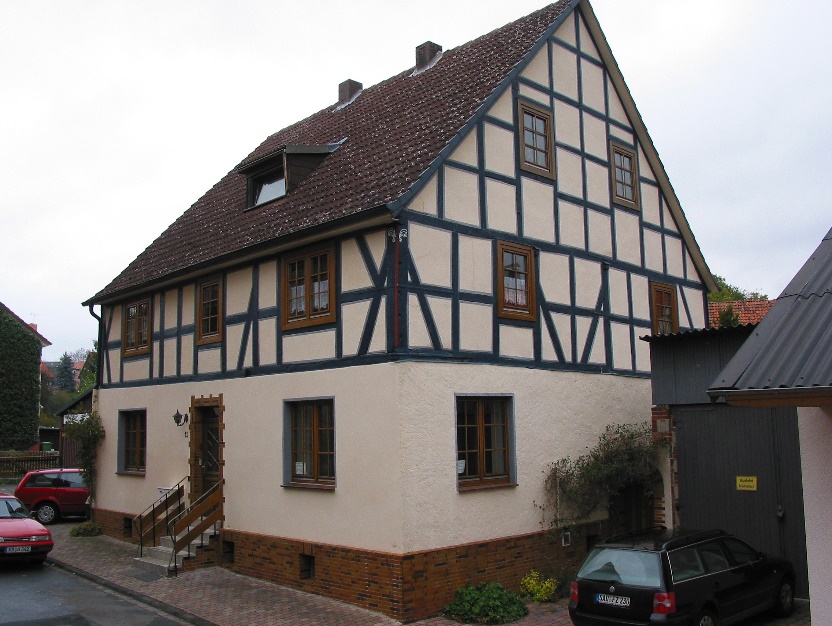
Photo: Walter Schauderna
One of the former Katzenstein houses in the lower Mittelgasse
On July 30th, an order is issued from Giessen to the district of Vöhl, listing the conditions for the construction of a proper mikvah:
- the building costs and maintenance are a matter for the Israelite community;
- the district doctor must certify that it is fit for use;
- the water must not stand for more than one day and must be drainable;
- the certifying doctor must take into account that "a Jewish bathing facility is only permitted if they use flowing spring, river or rain water, which is conducted through gutters";
- Earth baths must be walled or similarly secured;
- cold baths are prohibited; the room must be heatable;
- the stairs into the room must be made of oak;
- an inspection by the physicus must be made once a year;
- a "married Jewish supervisor" is to be provided for the bath.
In March of the following year, the government recommends to the district councillors that they draw the attention of the Jewish communities to a paper by Birkenstein, a Jewish teacher from Battenberg, in which he deals with the "bathing of Jewish women" and which is very useful.
In 1835/36 the Mikwahs again become a discussion topic.
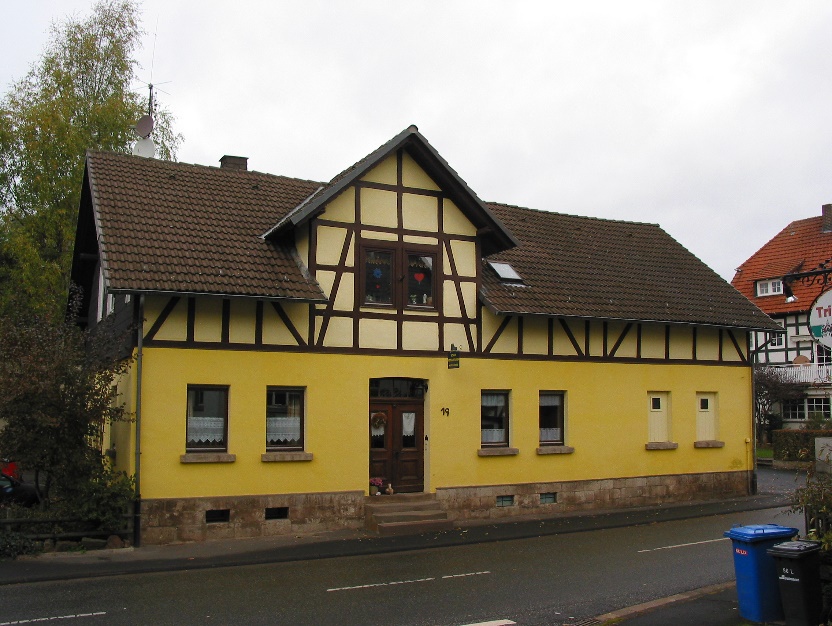
Photo: Walter Schauderna
Selig Stern's house used to stand here, and there was a mikvah in it.
The picture shows a property in the Arolser Straße, on which 3 houses of Jewish families used to stand; also the house of the Schönhofs, in whose cellar there was a mikvah.
back↑
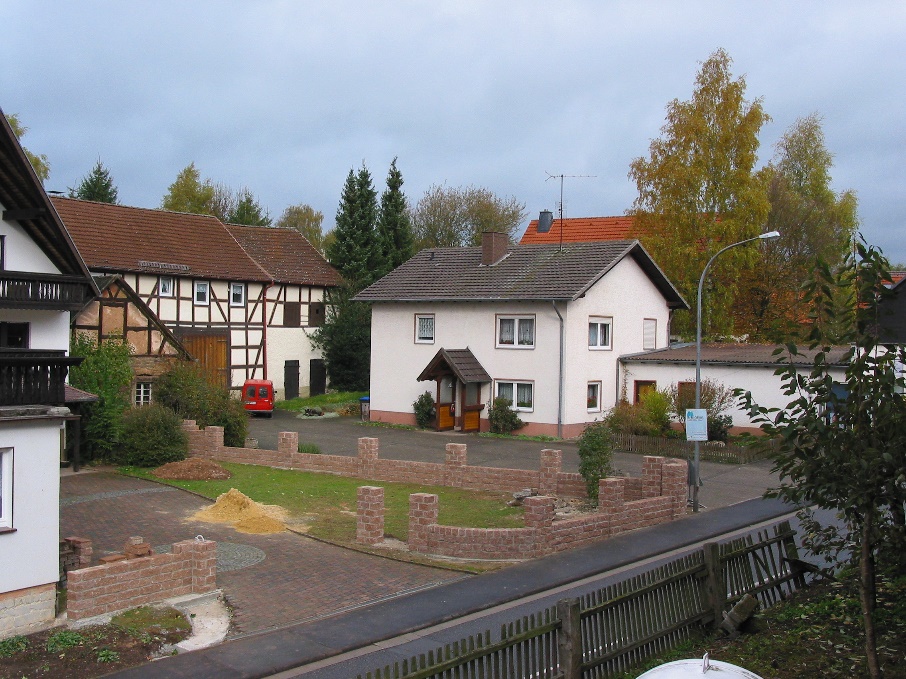
Photo: Walter Schauderna
The Schönhof house with a mikvah, among other things, stood on this property.
Mayor Knoche from Marienhagen visited the cellars of all Jewish families, but "found no wells or bathing holes in any of them. The new doctor, Dr. Nuß, found a different situation in the other towns in the district. In Altenlotheim and Höringhausen he found one bath each, in Eimelrod two; furthermore "one in Basdorf in the home of Feist Kaiser ...and three in Vöhl in the homes of Selig Stern, Joseph Kugelmann and Ascher Rothschild." With the exception of the baths in the Rothschild house, all were unsuitable, small holes in dull cellars, with bad, foul-smelling water, sometimes only accessible with great difficulty. The Rothschild women's bath was also suffering from these defects, but had an elegant appearance, even the very "practical facility ... that heated water can be fed directly into a kettle installed above the bath. Dr. Nuß forbade all except Rothschild to use their baths and informed the mayors involved accordingly. Selig Stern and Joseph Kugelmann explained "that they had not used them for bathing for a long time - but that they could not have them closed for the reason - because otherwise the cellars would be full of water", a statement that the physicist did not want to doubt. Dr. Nuß wanted to have the Jewish communities pay for the inspection of the baths; the Basdorf Jews do not seem to have agreed, because in October 1836 they were still threatened by the district council with garnishment because of the 1 ½ gulden fee.
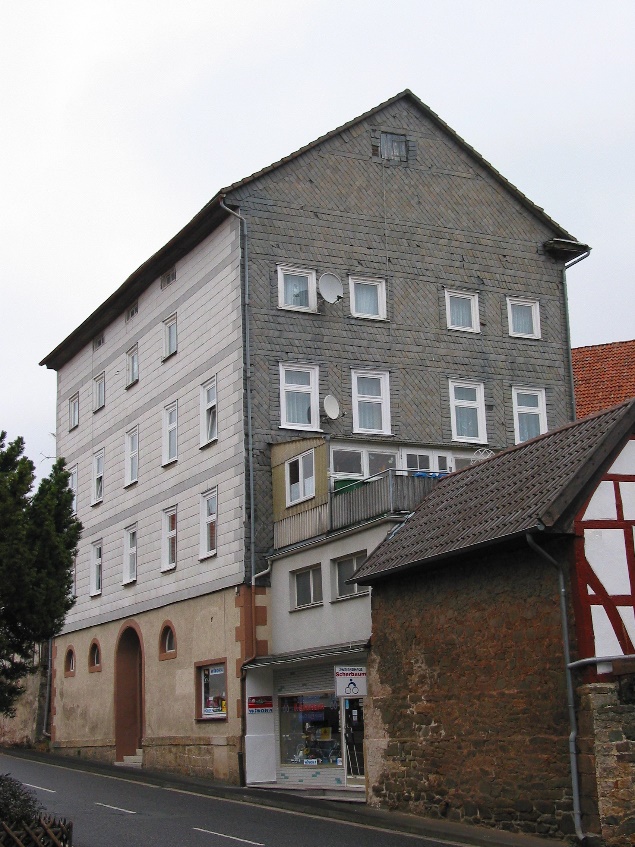
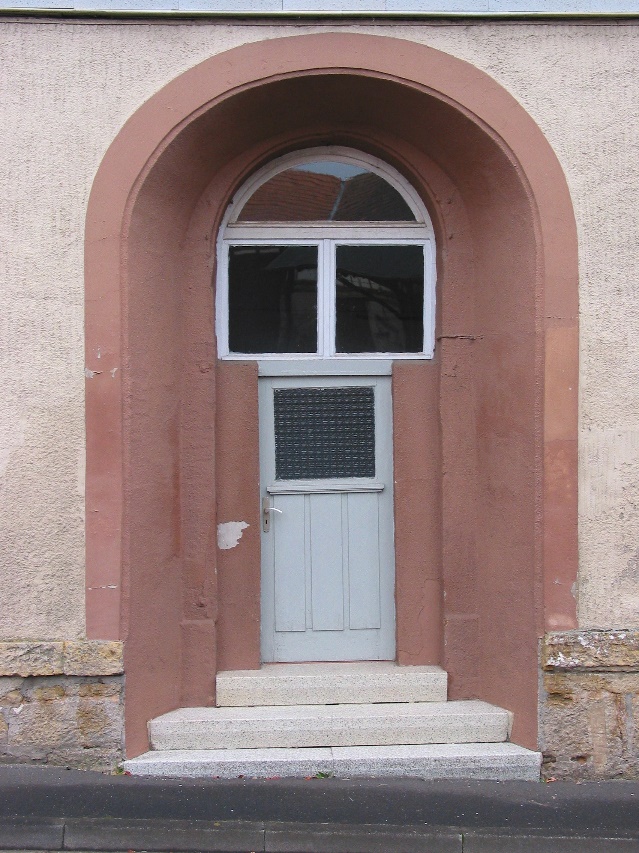
Photos: Walter Schauderna
House of Ascher Rothschild with the door to the presumed mikveh
In June 1840, written communication about the women's baths continued. There were also voices within the Jewish community calling for new baths. For example, the fruit and cattle trader Moses Schaumburg, a member of the Jewish community council, wrote to the Vöhl "Gerichtsrat" (court council) on June the 26th: "According to the supreme decree of 1831 of the RGb No 77, the women's baths for the Israelites should be set up in such a way that they do not harm the community as a whole! Unfortunately, this is not the case here - I reported this matter several years ago. He continues: "I therefore request the Gr. Greisamt to order that the goal is finally getting achieved, and a new women's bath for the Isralite community is built according to the highest decree, which is certainly an important need, and must therefore ask for an early decree". With reference to Schaumburg's letter, the District Council asks the Jewish community to "give the matter consideration, consultation and send in a report.”
On July 6th, the merchant and dyer Salomon Kugelmann, living in house No. 26, today Arolser Straße 23, and Moses Schaumburg answered on behalf of the Jewish community board: "1.We are willing to build a new bathhouse, but with the reservation that we will not be able to build it with our own means, because the community has built a new house of God only 10 years ago, which cost over 3000 ? and has already paid for almost all of it so if we owe such a building, we now ask the Grand Hessian Commissioner for a grand to build it. We ask for permission to borrow such capital, because we are not in a position to purchase it from our own resources. I, as Vorster Kugelmann, request an early ... (probably meaning answer or permission; the word is not mentioned in the original), because we must have a construction report from the ... "Kreisbaumeister" about it and buy a suitable bath for it."
Apparently, afterwards nothing was done. In 1853, a report on health and social services in Vöhl complains about the poor condition of the Jewish women's baths. At least one could be built in Vöhl, and "the Basdorf Jews would like to participate in this." However, the council of the Jewish community does not agree: there is no need to build a bath from the community's funds. In 1860, the district office urged again, and in 1861 even ordered the construction, but in letters from 1861 and 1862, the Jewish community, which was becoming more confident, rejected it. There were privately owned women's baths, and the community could not afford to build one because the costs would be too high.
There are no documents on this subject from the period after that; perhaps because Vöhl files from the period after 1866 were no longer collected in the Marburg State Archives, but perhaps also because the Prussian government, which was responsible for this district after the War of 1866, no longer cared about this subject. We now know of two, perhaps three privately owned Mikwaot that were available for use in the following decades. Ursula Behrend, born Mildenberg, who lived in the house below the synagogue in the Mittelgasse, says that before her time, probably before 1924, there had been a mikvah in the house of her parents: "... in the old sausage kitchen opposite the laundry room".
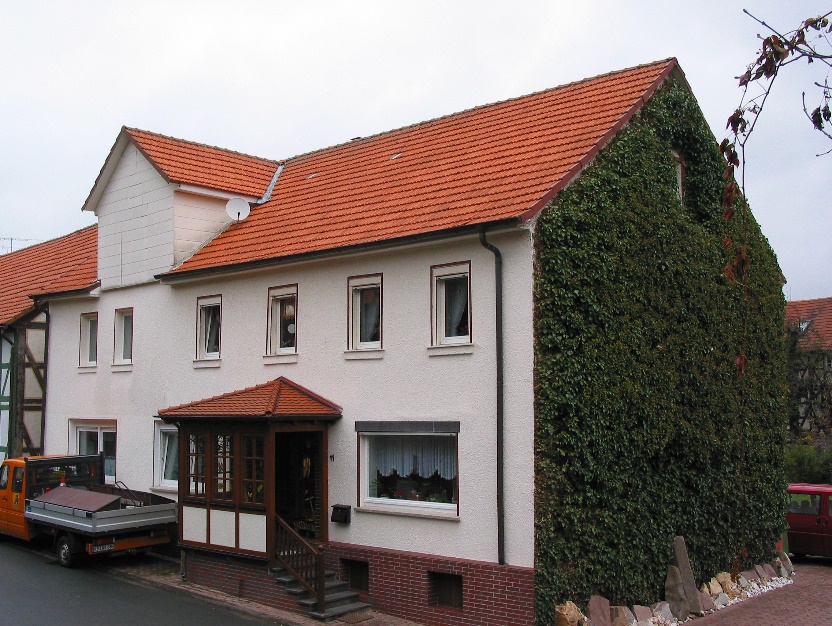
Photo: Walter Schauderna
The house formerly belonging to Sally Mildenberg in Mittelgasse, which had a mikvah in the cellar.
Mrs. Anneliese Bender, née Braun in 1913 in the house Heinze (later Ruhwedel and Urmoneit, today functioning as a retirement home) in the Arolser Straße, who was living in Vöhl until 1918 and then again during the 2nd World War, can remember that in the house of Ascher Rothschild, in the area of the bakery, there was a "well" in the house, which we certainly can imagine as a mikveh. If we further assume that there was a separate entrance to this room , as we can still see today, then this mikvah was definitely also easily accessible to the other Jews of the village.
Mrs. Krauß-Backhausen knows through hearsay that in the cellar of the house that nowadays belongs to family Demmer in the lower Mittelgasse there was a mikvah "built over the creek". This is probably the mikvah in the house of either Bär or Simon Katzenstein mentioned previously. How the formulation "in the cellar ... built over the creek" is to be understood exactly, is not quite clear yet.
An interpretation of the documents presented here on the Mikwaot in Vöhl must be made with great caution. It would certainly be rather hasty to assume that the authorities who ordered the women's baths to be filled in or made unusable were hostile to Jews. After all, statements by Jews themselves also prove that the mikvaot were in poor condition. Some formulations of the physicus Goldmann or also of the government authority in Giessen seem exaggerated, perhaps also hypocritical in relation to their concern for the health of the bath users. However, every now and then, the purpose of the measures definatly seems to be only to annoy and obstruct the community.
A distinction must be made between the attitude of the government in Gießen and that of the district office in Vöhl, at least during the term of the district council Krebs. Krebs seems to have been "closer" than his superior authority; he tries to soften directives and apparently also has the courage to decide differently from what he was told. The mayors of Vöhl, Basdorf and Marienhagen also wanted to help their Jewish community members; their reports that there were no women's baths in use in their villages were not very convincing and were probably given with the intention of helping the Jewish community to not get in trouble.
On the other hand, one also gets the impression that the Jews of Vöhl were not too faithful to the Bible or "orthodox", at least with regard to the use of mikvaot. The religious rule is one thing, its compliance quite another. Over the centuries, men in particular gradually got rid of the pressures and rules concerning the immersion bath, some openly, others secretly at first. External circumstances - their work, the social or even the rural environment - led them to become careless and finally to abandon the old rites altogether.
Perhaps adaptation and assimilation into the majority population were weaker in 19th century Vöhl than in the Jewish centres in Frankfurt or Berlin, but there was certainly a tendency for a weakening of devotion here as well.
It must have been more difficult for Jewish women to break away from the traditional obligations to immerse themselves in the bath, as they used the bath in situations that had to do with sexuality and the intimacy, since it was not talked about in public or at home. But women also became more open and free. We know from several Jewish women that they continued their husbands' businesses after their deaths. Johanna Blum even seems to have been a very successful businesswoman at the end of the 19th century.
The Vöhl Mikwaot in the 30s and 40s of the 19th century were probably in the bad condition that has been described. But one also gets the impression that they were not really used on a regular basis. They were there, and that was possibly enough to calm the religious conscience or to maintain the appearance of devotion. Surely there were people like Loeb Moses Schaumburg who insisted on the religious laws being followed, but that faded away over time.
(All quoted files are in the Marburg State Archives, fonds 111 k Vöhl 295.)
Bibliography:
Thea Altaras: Das jüdische rituelle Tauchbad; Synagogen in Hessen - Was geschah seit 1945? Teil II, Königstein im Taunus 1994 (The Jewish Ritual Immersion Bath; Synagogues in Hesse - What has happened since 1945? Part II, Königstein im Taunus 1994)
Ruth Gay: Geschichte der Juden in Deutschland. Von der Römerzeit bis zum Zweiten Weltkrieg, München 1993 (History of the Jews in Germany. From Roman Times to the Second World War, Munich 1993)
Nachum T. Gidal: Die Juden in Deutschland von der Römerzeit bis zur Weimarer Republik, Köln 1997 (The Jews in Germany from Roman times to the Weimar Republic, Cologne 1997)
Jüdisches Museum, Frankfurt am Main, Texte von Georg Heuberger, München/New York 1997 (Jewish Museum, Frankfurt am Main, texts by Georg Heuberger, Munich/New York 1997)
Jüdisches Museum, Museum Judengasse: Katalog zur Dauerausstellung, Frankfurt am Main 1992 (Jewish Museum, Museum Judengasse: Catalogue of the permanent exhibition, Frankfurt am Main 1992)
Alfred J. Kolatch: Jüdische Welt verstehen. Sechshundert Fragen und Antworten, Wiesbaden 1999 (Understanding the Jewish World. Six Hundred Questions and Answers, Wiesbaden 1999)
[3] Dem Verfasser dieser Zeilen ist ein solcher Gedanke absolut fremd: Menschen, die in festem Glauben an die Bedeutung und Wirkung des Bades dort tauchen, sind doch auch von Gott nicht deshalb zu bestrafen, weil andere bei der Errichtung der Badanlage Fehler begangen haben.
The CVs were compiled by Karl-Heinz Stadtler.
- Lebensläufe Buchstabe A
- Lebensläufe Buchstabe B
- Lebensläufe Buchstabe C
- Lebensläufe Buchstabe D
- Lebensläufe Buchstabe E
- Lebensläufe Buchstabe F
- Lebensläufe Buchstabe G
- Lebensläufe Buchstabe H
- Lebensläufe Buchstabe I
- Lebensläufe Buchstabe J
- Lebensläufe Buchstabe K
- Lebensläufe Buchstabe L
- Lebensläufe Buchstabe M
- Lebensläufe Buchstabe N
- Lebensläufe Buchstabe R
- Lebensläufe Buchstabe S
- Lebensläufe Buchstabe SCH
- Lebensläufe Buchstabe ST
- Lebensläufe Buchstaben O-Q
- Lebensläufe Buchstaben T - Z
by Karl-Heinz Stadtler 2021
Translated by Kimberley Simon
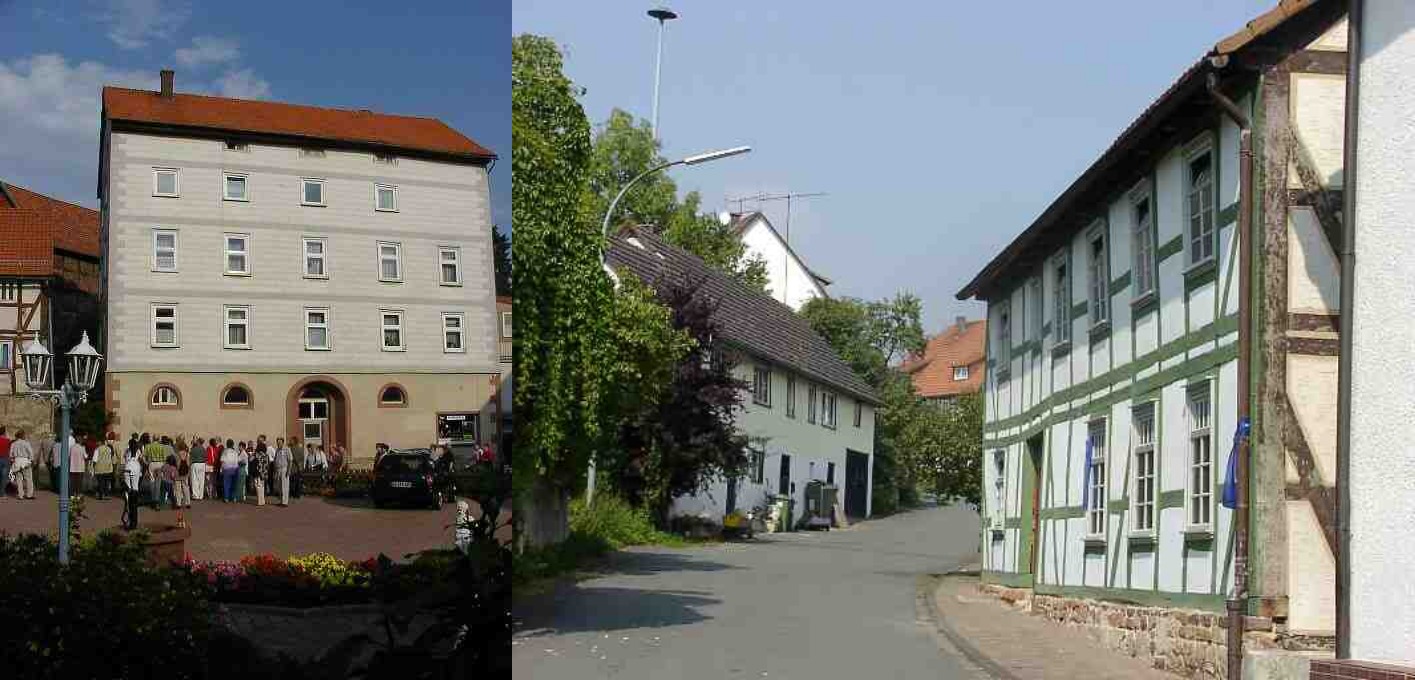
Fotos: Kurt-Willi Julius
Schulstandorte in der Arolser Str, 8 und Mittelgasse 9
Content
Please press the button to reach the outline items:
read more
|
School education and learning in Judaism
"If you have created children, instruct them at all times, however, do that gently. Spend all you have to buy them books, and keep a teacher for them from their earliest years. Pay the teacher generously; what you give him, you give to your son. And know that your happiness will be increased by your children, and that their welfare will be yours. Let your sons learn skills; It will do them good for the future. Until you have gained wisdom and insight yourself, keep the company of experienced men, and do not be ashamed to learn and to ask. Be the tail of the wise, and you will one day become a leader. But wisdom is walking in the ways of faith, fearing God and shunning evil, that is insight. Learn wisdom, and if it is difficult for you to understand, at least learn mathematics and read medical books." (from: "Musar Haskel" by Gaon Hai ben Sherina (939-1038); quoted from Alfred Pfaffenholz: What does the Rabbi do...? Judaism, Munich 1995, p. 148) This quote from a famous rabbi, which is about one thousand years old, is an indication of the great importance that learning, parenting and education in Judaism has. Learning was never reserved for a few - e.g. the priests - but was a general goal. Even the Jews of Eastern Europe, who lived in almost unimaginable poverty: they often could not afford to eat properly, went barefoot until autumn, had only one pair of boots for the whole family to wear in winter, but they paid a teacher for their sons, who often taught them to read, write and pray in Hebrew from the age of three. This sacred duty of Jewish families results from a rather insignificant verse of the Torah: "Teach them to your children, talking about them when you sit at home and when you walk along the road, when you lie down and when you get up." (Deut. 11:19). In the Jewish religion, in addition to the Torah, there are the Mishnah and the Gemara as rabbinic interpretations, and interpretations of the Torah, which make up the Talmud. There it says in an old commentary of a rabbi: “Your sons but not your daugthers….Thus they say: As soon as the boy begins to speak, his father speaks to him in the sacred language and teaches him Torah. If he does not speak to him in the holy language and does not teach him Torah, it is as if he buries him." The obligation to teach therefore originally rested with the father; but if he was unable to instruct the son, he had to ensure that a teacher fulfilled the task for him. Another thing is shown: only boys had a "right for education". This did not apply to girls. However, many families who could afford it also provided education and training for their daughters. At the beginning, the mother educated her daughters at home, and especially during the so-called "emancipation" period, which began with the Enlightenment era and resulted in the "Napoleonic era" with the introduction of many principles of freedom, daughters were also sent to public schools. |
||
| Education for Jewish children before 1827 It is still unknown since when Jewish children in Vöhl were taught by a Jewish teacher. In Vöhl records, "the Jewish schoolmaster" appears for the first time in 1799. We neither know his name nor how many children he taught. It is possible that he only gave religious instruction and that the children otherwise went to the Protestant school, but it is quite possible that at the end of the 18th century Jewish children were not yet admitted to the Christian school or that they were charged special fees, which could have led to only a few of them attending the school. But none of this is known to date. In the district of Vöhl in the Grand Duchy of Hesse-Darmstadt, Jewish children were also allowed to attend school free of charge following the occupation by Napoleon's French troops and the introduction of freedom rights in 1825. What this meant, however, was attendance at the state school. Only in religious education were they usually allowed to have their own teacher. This was probably also the case in the Jewish community of Vöhl, Basdorf, Marienhagen and Oberwerba. In June 1824, a letter from the Grand Ducal Hessian Church and School Council was made public in Vöhl by Mayor Küthe, according to which the connection of a shepherd with that of a school teacher was forbidden. (The shepherd had to kill animals in the ritually prescribed manner so that it could be eaten afterwards). The teacher was allowed to be the precentor in the synagogue at the same time, and the precentor was allowed to exercise the office of the shepherd, but the teacher was no longer allowed to slaughter. The fact that this notice was announced in Vöhl suggests that there was a Jewish teacher at that time. There was probably even someone in Marienhagen who taught Jewish religious education, because on February 1st, 1826, Vöhl's district administrator Krebs wrote to the Marienhagen deputy Klein that he would have to fine him 10 guilders because the above-mentioned order was not being followed in Marienhagen. As late as October 19th 1827, District Administrator Krebs reported to the Church and School Council in Giessen that all Jewish communities in the district, i.e. "Vöhl, Basdorf, Höringhausen, Alt-lotheim, Marienhagen, Eimelrod", sent their children to the Christian elementary schools. From these various documents it can be concluded that the children were indeed taught together, and were only separated when it came to religion. From this we can see that it was quite common for the teacher to also have the function of the precentor or priest in the service, to celebrate the bar mitzvah of the boys, the weddings and funerals, but also to perform the office of the shepherd, who slaughtered the sheep, goats or cattle at the numerous Jewish butchers according to strict ritual rules. In 1825, a order was issued by the Hessian Church and School Council in Giessen, which placed poorer Jewish children on an equal footing with poor Christian children with regard to exemption from school fees. |
||
| Why was there a jewish school in Vöhl? Some general reasons for the establishment of a Jewish school have already been mentioned: - the religious obligation to teach the sons something about the Torah and Talmud; - related to this: the great respect that education and learning enjoyed, especially among Jews; - the introduction of freedom and equality rights at the beginning of the 19th century. In addition to that, there was a large increase in Jewish population in the district of Vöhl in the 1920s and 1930s. By 1840 the Jewish community had grown to about 140 people, which corresponded to a percentage of about 20% of the population in Vöhl alone. The growing numbers combined with the freedoms granted created self-confidence among the Jews: We are somebody! We no longer need to hide! We can claim the same rights as our Christian neighbours. During these years, various institutions were created; apart from the school, these included the synagogue and then, soon after, the Jewish cemetery. However, one could now question why there had to be a school with religious focus. Couldn't the Jewish children go to the normal primary schools just like the other children? As already mentioned, this was the case until the Jewish school was built in Vöhl. The Jewish children attended the school together with the Protestant children; only the subject religion was taught separately. This was also the intention of the government. The Grand Duchy of Hesse-Darmstadt wanted to control what was taught in the schools. The government had to ensure the quality of teaching and the comparability of school-leaving qualifications. And this was only possible if the government hired the teachers and controlled the teaching content and the performance of the teachers through the school councils. Moreover, there was great distrust towards the Jewish teachers, who were accused of being "strict Talmudists", or even rabbis, whose teachings included lying to and deceiving the "goy", i.e. the unbelievers. However, the joint teaching also created difficulties. The Christian children were taught from Monday to Saturday. The Jewish students, however, could not be expected to attend classes on Shabbat. The different holidays throughout the year also prevented them from working together. The crucial factor, however, was certainly that all subjects in primary school were very strongly religiously influenced. Reading and writing were learned with the help of the Bible and other religious writings. Songs by Martin Luther or Paul Gerhardt were sung, and the poems that had to be learned also came from the Christian-dominated Western culture and tradition. School supervision was exercised not only by the school board but also by the Protestant pastor. In view of all this, it makes sense that Jewish parents tried not to send their children to public schools. For secondary schools, where the focus is more on specialised instruction, this question was not raised in our area. Jews from Vöhl sent their sons to the secondary school in Korbach, which will be discussed later. |
||
The construction and financing of the school in Mittelgasse The school constructed in 1827 in the Mittelgasse 9 (Photo: Kurt-Willi Julius 2004) According to the inscription on the beam of the Vöhl synagogue, the building was constructed in June 1827. A synagogue was probably planned from the beginning, but the house initially served as a school, as we know from several documents. In spite of these documents, it is very unclear how intensively classes were held in this house at the beginning. As late as October 1827, the district of Vöhl reported to the school board in Gießen that the Jewish children in all the villages of Vöhl were being taught in the public primary schools. A letter from November of the same year shows that the school was already in use. However, there are also various documents from the following years - until 1835 - which suggest that the Jewish children still mainly remained in the puplic school and were only occasionally taught by a Jewish teacher in the synagogue. The document mentioned, dating back to November 1827, deals with a conflict between the Jews of Vöhl and Marienhagen on one side and those from Basdorf on the other. Now that it was a matter of paying for the building, the family leaders from Basdorf no longer remembered the agreements made previously. One could not remember ever committing to anything; another said that the Basdorf community had grown so much in the meantime that one had to think about a school of one's own; a third added that he was too old to still use the school and that he had definitely not made a commitment in the past. And then several referred to the rich Ascher Rothschild, who allegedly paid less than he had promised before. |
||
| back ^ | ||
|
Teacher David Schönhof The school board's reply stated that it was also in the interest of the Jewish community not to simply tolerate making any person a teacher. The goal must be good teaching that allows the students to receive a good education, and therefore the government must decide who the teachers should be. In addition, the school council was disturbed that the creation of the teaching position was tied to Schönhof's personality. If a school was to be established, then this should be done regardless of specific persons. The final hiring then took place by decree of the Grand Duke Ludwig at the end of 1836. The headmaster of the school became Selig Stern. Subsequently, the mayor, the Protestant pastor and two Jews chosen by the mayor and pastor were members of the committee desiting about his employment. David Schönhof lived in the school and synagogue building with his family. In 1840 his family consisted of 3 persons over and two persons under 8 years of age; he also owned a sheep or a goat, probably keeping it in the small stable in the cellar. We do not know exactly where he taught; if he did not teach in the sacred room, then he did so in one of the rooms he stayed in. The room to the left of the entrance door seems the most suitable. However, the number of children was so large that it would certainly not have been possible to teach all the children in this room at the same time. Either there were two classrooms at Schönhof's disposal, or he taught the children - perhaps separated by boys and girls - at different times. Schönhof did not remain a teacher in Vöhl for the rest of his life, as the contract intended. At the beginning of 1841 he announced to the Vöhl district council that the funds granted to him by the Jewish community would no longer be enough to heat the schoolroom. At the time the contract was signed, a certain amount of firewood had been made part of his salary. That amount, however, would have never been enough. But because of how low the cost of wood was, the Jewish community provided him with a larger quantity. But now the community is no longer willing to provide this additional service because the cost of wood has increased dramatically. According to him, the district council should assure that the Jewish community would supply the necessary wood; otherwise he would no longer be able to heat the schoolroom to the required level. We do not know what happened to this complaint. In the course of 1841, however, Schönhof stopped working as a teacher. His successor Salomon Baer wrote in the school chronicle, which was started in 1878, that Schönhof had been offered a teaching position in Oppenheim on the Rhine.From 4 December 1839 to 1 April 1841, this post was held by Salomon Baer, who was then appointed head of the Vöhl school. |
||
Teacher Salomon Baer Teacher Salomon Baer After receiving the certificate of appointment from the sovereign in November 1841, he was the sole teacher of Jewish children in Vöhl for 40 years. He taught whole generations of students during this long period. In addition, Baer served as precentor and, for a time, as accountant of the Jewish community. As a co-founder of the bowling casino society and as a tutor for the children of officials in Vöhl, he quickly became one of the town's important figures. Born in Wimpfen, he attended higher education and then a teacher training seminar in Friedberg. The Protestant church book reports that he passed "the qualifying exams with excellent results" and calls him an excellent teacher; and since the pastor took part in regular inspections of schools, one can certainly believe that he had the necessary knowledge for such an assessment. Baer's wife Minna, née Liebmann, was probably the sister of Salomon Liebmann from Vöhl. Anyway, there was a proven relationship between Salomon Liebmann and the Baers. Salomon Baer took over the guardianship of Liebmann's son Emil, probably because Emil was a son from his father's first marriage; and furthermore, in 1881 it was Salomon Liebmann who reported Baer's early death to the registry office. It is possible that Minna was the reason for Salomon Baer to come to Vöhl. However, it is also possible that Baer didn´t meet his future wife until he arrived in Vöhl. By the way, Baer took over further guardianships. When Abraham Kaiser died and left behind four children from his second marriage, he was willing to take care of them. How labor-intensive such a guardianship was can be seen from the fact that Salomon Baer had to write an annual report for Emil Liebmann - there are no such documents for the other guardianships - in which he described the development of the child. Baer's obligation did not end until Emil had completed his training as a merchant in southern Hesse. Salomon and Minna Baer had four children, one of whom died in infancy, the eldest son when he was about 20 years old; he had probably been rather weak. Baer also took his younger brother into his home, when he came to Vöhl to recover from illness, probably taking advantage of his brother's kindness. Salomon Baer's first years in Vöhl included the major renovation of the synagogue and school building. We have records of the various workers and contractors who were involved, and we know the expenses of the renovation. But unfortunately we do not know exactly what work was done. A report from the government in Giessen states that the condition of the building was so bad that it would be cheaper to tear it down and rebuild it. It is mentioned that the floor and walls had settled because of the closeness to the river. It is also possible that the ceiling of the main room was removed and the women's gallery was built. At least, the former synagogue room gives the impression that it was not a two-story room from the very beginning: Beams seem to be cut off; the metal cross for the chandelier in the center of the room may also have been inserted to replace beams that were there before. From Baer's time as a teacher and precentor dates a list of the property of the Israeli community, from which one can conclude the furnishings of the schoolroom as well. There were five benches, five desks, two blackboards and ten so-called lute and reading boards. In July 1847, the government of the Grand Duchy of Darmstadt issued a law on Jewish schools. The language of teaching was to be German. Whether such a school would be established was a matter of the Jewish community alone, since the children had the option of going to the public school. The political community, though, would have to contribute to the costs if it had also done so for the other school. However, it was forbidden for non-Jewish children to go to the Jewish school. In the 1960s, there was a conflict over the teaching of Hebrew. Due to state decrees, this was reserved for higher educational institutions. But the community in Vöhl wanted these lessons for their children. Baer did not want to do this for a normal salary, but wanted a special payment for the instruction in Hebrew. At the end of 1867, a more detailed exchange of letters took place. Selig Frankenthal complains that his three children attending the school are beaten with a ruler by Baer's son Adolph and his foster child Emil Liebmann when Baer is not present, which often happens. Baer justifies himself with being overworked. Since the summer he had to teach in the Christian school as well. And because his precentor duties were very busy during the holidays in the fall, he could not fulfill all of his teaching obligations. In addition, he admitted that he wanted to blackmail the board of the Jewish community a little. The broken stove had not been repaired despite winter temperatures since the board wanted to save the money. And because the children of the board members were now attending school, he had sent them home because of the freezing temperatures in the classroom - in the hope that this would soften their parents. From 1871/72 there is a report on the inspection of the school and lessons. School inspector Meyer from Höringhausen visited the classes together with pastor Saugmeister (?), school board member Schönthal, teacher Sandlos and district administrator Vorwinkel. At first, it was about the teacher's salary. Baer received just over 232 Thaler a year, including an old-age allowance; since he also gave private lessons, the school inspector thought that Baer had a "sufficient income" despite the expensive living costs. After Salomon Baer died on June 1st, 1881, the Jewish students of Vöhl initially attended the Protestant school led by teacher Sandlos until February 1st, 1882, during which time Sandlos received a special bonus of 300 Marks. |
||
The school in the Ackerrijje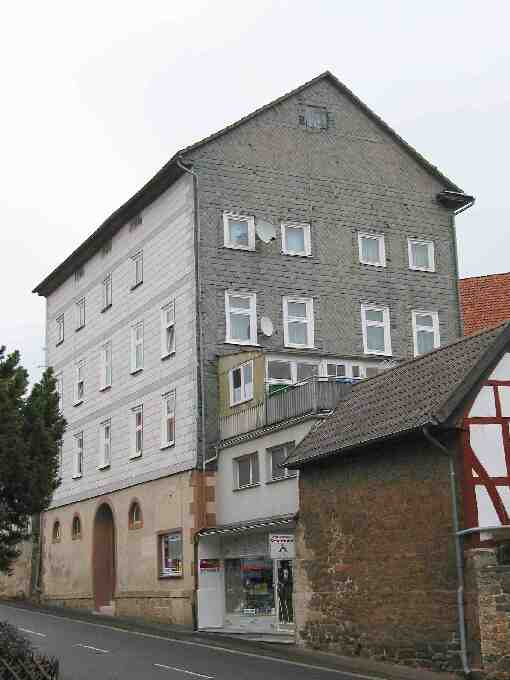 Haus Rothschild, Arolser Str. 8 (Photo: Kurt-Willi Julius) Around 1836, Ascher Rothschild built the large house in today's Arolser Straße, formerly called "Ackerrijje" because of the large farms in this street. In the same century, but in a year that is not known yet, the Jewish school moved there. Perhaps this happened after the death of Salomon Baer, as from that time on the living quarters in the synagogue building were no longer occupied by Jewish teachers, but by members of the Mildenberg families up until 1938. After Baers' death, Emanuel Katzenstein, who had been appointed by the board of the Jewish community in Vöhl, traveled to Münster in Westphalia to find a suitable teacher candidate. Director of the seminary Dr. Steinberg suggested Joseph Laser. Katzenstein visited Laser at his home in Neheim an der Ruhr on Thursday, December 1st and invited him to travel with him to Vöhl immediately to hold a service and lecture on the following Sabbath. Joseph Laser accepted the invitation, introduced himself to the board of the Jewish community and was then recommended by them to the Royal Prussian Administration Office to fill the school position.^2 On January 25th, 1882, Laser received the order of appointment as teacher and cantor from the royal government in Kassel. ^3 On February 1st he was appointed by the pastor and local school principal Sessler (? ) ^4 and on February 2nd he was sworn in by the district official Engelhard in Vöhl. On January 24th, the local school inspector visited the lessons in religion and mathematics. ^2Source: The Jewish Historical Archives, Jerusalem, 8273/3 (school chronicle, written by Laser himself). On June 15th, the local school inspector visited the classes for the second time and informed on this occasion that the teacher was not allowed to offer lessons beyond the scheduled lessons. On July 5th, from 8 to 11 a.m., the first real school examination took place by the local school inspector, who expressed his full satisfaction; a follow-up examination by the head school inspector Meyer from Höringhausen took place on July 10th. On July 18, "at exactly seven o'clock", the local school inspector checked the punctual start of classes. Exactly one week later, he checked the school chronicle and informed about the beginning of the 14-day summer vacation on August 7th. On November 15th, he checked the students' performance in reading and noted significant improvements among weaker students. He also warned against reading the Hessian school newspaper. He justified this with an article issued in the edition 39/1882, in which also the religious school inspection had been attacked. ^5 The chronicle reports of many inspections, which, however, were generally satisfactory. Almost every year Laser reported who was newly admitted to the school at Easter and who left it. Readers also learn about local life. Laser reported, for example, on epidemics to which some children - including his own - died. 1882 On January 25, 1882, Laser received the order of appointment as teacher and cantor from the royal government in Kassel. On February 1st he was inaugurated by the pastor and local school inspector Sessler? and on February 2nd he was sworn in by district official Engelhard in Vöhl. On January 24th the local school inspector visited the classes in religion and mathematics. On June 15th, the local school inspector visited the classes for the second time and on this occasion informed that the teacher was not allowed to offer lessons beyond the scheduled classes. On July 5th, from 8 to 11 a.m., the first real school examination was performed by the local school inspector, who expressed his full satisfaction. On July 10th, the school inspector Meyer from Höringhausen repeated the examination. On July 18th, "at exactly seven o'clock", the local school inspector checked the punctual start of classes. On July 25th, the local school inspector checked the school chronicle and informed about the beginning of the 14-day summer vacation on August 7th. On November 15th, the local school inspector checked student performance in reading and noted significant improvements among weaker students. He also warned against reading the Hessian school newspaper. He justified this with an article written in its edition 39/1882, in which the religious school inspectorate had also been attacked.^6 ^5/6 Paul Arnsberg writes in " The Jewish Communities in Hesse" that Laser had been a teacher at the Jewish school since 1885, temporarily until 1895, then permanently. The school chronicle proves that this is not correct. Laser was therefore the successor of Salomon Bär, who died in June 1881. Between the death of Salomon Baer and the start of Joseph Laser's service on February 1st, 1882, the Jewish children were taught in the Protestant school by teacher Sandlos, who received a gratuity of three hundred marks for this according to the "Order of the Royal Government for Schools and Churches in Kassel". (Source. School Chronicle, The Jewish Historical Archives, Jerusalem , 8273/3) 1883 On January 26th, he registers the birth of his daughter Mathilde Emilie on January the 19th at the registry office. On April 17th, Pastor Pflug performed his first school examination as the new local school inspector.^7 1884 On July 8th, Pastor Pflug again inspected the school. On July 15th, High School Inspector and Dean Meyer from Höringhausen came and expressed his satisfaction with the performance of the students. ^8 1885 On Sunday, March 8th, diphtheria spread among the teacher's children. On the basis of a ruling by the Royal Administrative Office, classes were canceled until April 13. ^9 On October 1st - during the autumn vacations - an epidemic of whooping cough was reported in Vöhl, which affected all the schoolchildren. It was not until Monday, November the 23rd, that classes could be held again. Laser writes in the chronicle that during the entire school year until spring 1886, the children repeatedly fell ill with whooping cough and the lessons suffered greatly as a result. ^10 1886 On Thursday, July 15th, a pre-examination was carried out by Pastor Pflug, and on July 19th head school inspektor Meyer returned, who subsequently voiced his satisfaction. In the summer of that year, the south side of the school building was completely renovated. During this time, classes were held in the synagogue. ^11 1888 On Tuesday, September 18th, the school inspection by Dean Meyer took place. He again stated that he was satisfied with the school. ^12 1889 Around Christmas, there was an influenza epidemic throughout Europe, which also sickened numerous children in Vöhl. In addition, there were cases of other childhood diseases, especially measles. The school therefore remained closed for seven weeks. ^13 1890 In September 1890, family members fell ill with diphtheria. The fall vacation was therefore extended by a few days. ^14 received a bonus of three hundred marks". (Source. School Chronicle, The Jewish Historical Archives, Jerusa-lem , 8273/3) ^7 Source. School Chronicle, The Jewish Historical Archive, Jerusalem , 8273/3. Joseph Laser was the first person that we know of who lived in the new building. He worked at the school for many years. Laser came from Hattenbach near Trier and moved to Vöhl with his wife and one son. His wife had several miscarriages and died in 1885 after giving birth. Laser married for a second time, and every other year his wife gave birth to a child. He died of heart failure at the age of 58 in 1906, just as he was about to give a toast on the loss of one of Abraham Blum's daughters. His funeral is reported in detail in the Corbacher Zeitung. The Jewish community formulated an obituary for the teacher who had held his office for almost 25 years. His achievements as a teacher and precentor were honored, the Jewish teacher Plaut from Frankenberg held the eulogy, and the Protestant pastor Kahler also spoke words of commemoration as school inspector; Dignitaries from Vöhl also took part in the funeral service. |
||
|
The Jewish school from 1881 to 1925; The schoolroom was located on the marked floor. The entrance was located at the other side of the building. The door with the round arch probably connected to the mikvah in this building. In the first quarter of the 20th century a bakery was opened here. During the time of Laser, there was a conflict with the political community about the financing of the bakery. The law stipulated that the community had to support the Jewish school if it also supported the Christian school. At the same time, however, a limit of 12 students was set, while in 1909 there were only 8 Jewish children attending the elementary school. The community no longer wanted to pay the contribution of 200 RM. Nevertheless, the superior authority demanded the continued payment of the fees. Joseph Laser began to write a school chronicle, which his successors continued until 1920. This chronicle is now in the Central Archives of Jewish History. It probably got there along other books of the Jewish community of Vöhl during the period of the nazi regime. This chronicle - later continued by teacher Louis Meyer - gives a good insight not only into everyday school life, but it also informs about other aspects of public life in Vöhl. In 2006, a great-grandson of Joseph Laser contacted the author of these lines. He had become aware of the website of the Förderkreis. He informed about the fate of his family after they had moved away from Vöhl. His grandfather Leopold, who had been born in Vöhl as the youngest child of Joseph Lasers' first wife, had trained as a merchant in Westphalia. He married, and his wife was blessed with three children; in early March 1943, the couple and their youngest son were deported to Auschwitz and killed. Kurt, the eldest son, was hold captive in the Dachau concentration camp after the Pogrom Night on November 9th. After his release, he emigrated to Sweden, where he lived until his death. Leopold's daughter Karla fled to Palestine in 1936 at the age of 16 with the support of a Jewish youth organization. She married, gave birth to a daughter and a son, and in 1958 the couple moved with their son to Germany, where the family initially lived in Frankfurt, moving to Hamburg after the father's death. Another great-granddaughter of Laser, in fact a step-granddaughter of his daughter Johanna, contacted the author in May 2010 and informed him about her grandparents. In particular, she sent a picture of the gravestone of her great-grandfather, the teacher Joseph Laser, which to date shows us the only photographic evidence of the new fence around the Jewish cemetery, financed by donations between 1904 and 1911. |
||
| What was it like in the schools of Korbach As already mentioned, several sons of Jewish parents from Vöhl went to the secondary school in Korbach. As early as the 19th century, we know of quite a number of Jews from the religious community who were educated there for a few years and left after completing and graduating from it.These included, for example, Leopold Külsheimer from Basdorf, son of Bendix Külsheimer, as well as Hermann Schönthal, son of Emanuel Schönthal, a horn turner from Vöhl; he was even one of the children of poorer families who afforded higher education for their children. Bernhard Frankenthal, Albert Katzenstein, almost all male Rothschilds, Ferdinand Kaiser or Louis Blum attended the schools in Korbach. Several of them stayed there only a few years to continue their education elsewhere; others left early to start a commercial apprenticeship. The Abitur does not always seem to have been the goal. Erna Katzenstein (Mainz) or the children of Ferdinand Kaiser (Marburg) attended higher schools outside the region. |
||
| During the First World War and the Weimar Republic From 1910 Louis Meyer worked as a teacher in the Jewish school until its end in 1925. In the first years (1912, 1915) he appears several times on donation lists of the Jewish community in favor of the improvement of the synagogue. ^15 1914 April: Meyer is finally hired as an elementary school teacher. The synagogue community pays his salary. At the outbreak of war at the beginning of August 1914, the Jewish school is dissolved or merged with the Protestant school, the second teacher (Jonas) is drafted and Meyer is hired as the second teacher in the Protestant school. He and his colleague have to teach in Obernburg on 2 weekdays. ^15 Source: fonds 1.75 A Vöhl in the archive of the "New Synagogue Berlin - Centrum Judaicum" Foundation 1915 Meyer is drafted in November 1915 (Landsturm with weapons). 1919 When he returns in February 1919, he is again employed and paid as 2nd teacher of the Protestant school; as of March, the Protestant and Jewish schools are again separated. June 30th: Meyer performs the church wedding of Hugo Davidsohn and Ida, née Frankenthal. On November 10th, he is given leave of absence; the 5 Jewish students are transferred to the Protestant school. 1920 Due to the small number of children, teacher Meyer has difficulties in having the parents' council elected. In February, the school authority in Frankenberg signals that no objection will be made if mothers are also elected, especially since this is possible anyway according to the election regulations. One of his sons needs an 8-day brine bath cure. Meyer applies to school inspector Broh-mer in Frankenberg for vacation for himself and his son, so he can accompany him to Sassendorf. The request is granted. ^16 1921 The " salary of the holder of the teacher's position in Vöhl, which is connected with religious service" is 1000 Mark. Teacher Meyer has 5 students, one boy and four girls. 1922 June the 27th: The district of Frankenberg informs the board of the Jewish community that the teacher is no longer obligated to serve in the cult office. The school board of the district requests the number of school children that can be expected in the next 5 years. The list of teacher Meyer: 1922: 6 children, 3 of them are his children; 1923 and 1924: the same; 1925: 5 children, 192: 4 children; three of them are children of the teacher; a first new enrollment was only to be expected again in 1927. ^18 ^16 Source: The Central Archives for the History of the Jewish People in Jerusalem. The number of Jews in Vöhl became smaller and smaller, and with it, of course, the number of school-age children decreased. During the First World War, the Jewish and Christian schools were temporarily combined, since one of the teachers of the Protestant school as well as the Jewish teacher Julius Flörsheim were drafted. After the war they were separated again. Flörsheim received an offer from a Frankfurt school and left Vöhl. Meyer stayed, but he had to teach mainly his own children. The available sources portray Louis Meyer as a difficult man to characterize. On one hand, he seems to have been a person who did not always get along well with others. On the other hand, he was a very political person, who especially stood out in his confrontation with Nazis. During his years at Vöhl, however, nothing is known of any political activity. The effects of a conflict with the old Karoline Rothschild, who after the death of her husband Moritz probably moved back to the birthplace of her husband, even became the subject of reporting in the Corbacher Zeitung. There it is reported that the widow Rothschild had left a barrel with freshly washed laundry outside overnight. And when she wanted to bring the clothes back in the next morning, she was horrified to discover that someone had tainted the laundry with aniline ink which led to the cooking linen being turned blue. The newspaper criticized the rude manners and asked who could do such a thing to an old woman. For Richard Rothschild, the old lady's grandson, the guilty person was absolutely clear when the incident was mentioned to him in 1999. "That was teacher Meyer," he said; Meyer had not gotten along with anyone, including his family. And indeed, we know today that Meyer was probably a man who kept to himself and who found it very difficult to establish closer relationships with others. In 1925 he moved to Korbach as a teacher, left the Jewish community there, survived the Holocaust -probably in East Germany- and then changed back to the Jewish faith. His wife and children had left him; she went to Israel, the children were in America. And thus Louis Meyer died a lonely old man in Cologne in the 1970s. Here, however, it should be noted that Meyer, like his predecessors, also performed ritual duties in the religious community. For example, when he married Ida and Hugo Davidsohn. But in the 1920s it was no longer possible to get the Jewish teachers to participate in the services. In 1921, the teacher who also provided religious services in the synagogue received 1000 Reichsmark. |
||
|
back ^
|
||
|
Education for Jewish children in the Third Reich
Which Jewish children in Vöhl were still required to attend school after 1933? First there was the youngest of Hermann Mildenberg's daughters, Charlotte. Then there were the two children Walter and Ursula Mildenberg, born in 1920 and 1924. Both Charlotte and Walter Mildenberg finished school in their second year after Hitler's appointment as Reich Chancellor. Ursula Mildenberg shared that Walter, as an athlete recognized by teachers as well as his peers, had no difficulties in school. His cousin Charlotte followed the example of her sisters after leaving school and went abroad to work as a domestic worker. Walter completed his training as a butcher outside of Vöhl in keeping with tradition. In the mid-1930s, Ursula Mildenberg was the only Jewish student at the school on the Schulberg. She has almost only bad memories of this time. She was teased a lot, sometimes accused of theft, and sometimes even beaten. It was particularly bad when her non-Jewish peers had race studies in the first lesson and she joined them in the second lesson. During the breaks, she did not stay at school or in the playground, but went to the Frankenthal houses. The teachers hardly paid any attention to her; she learned very little. At the end of 1937, she emigrated with her parents to the USA via Frankfurt, where they left her grandmother with relatives. For Günther Sternberg, who was only six years old and the youngest Jewish child in Vöhl, this meant that he now had to go to school in Frankfurt. Israel Straus, a little older than Günther and coming from Altenlotheim, reports in a letter that he attended the Jewish Philanthropy School in Frankfurt together with Günther Sternberg. They had initially lived in a Jewish children's home run by the Flörsheim-Sickel Foundation. He and Günther did not go to the same class and did not sleep in the same room, but they often played together and always went home together during the vacations, he to Schmittlotheim and Günther further to Herzhausen. After the summer vacations in 1940, they had to move to the Jewish orphanage, since the children's home had been occupied. According to his recollection, in October 1941 some children, including he and Günther Sternberg, were sent to their parents to be deported. Israel Straus and his family were taken to the Riga ghetto in December 1941. Some other children of the Philanthropy School would have belonged to this transport, but Günther was not among them. As we now know, Günther Sternberg and, according to witnesses, his parents were also deported - although a few months later - first to Wrexen and from there to the East. Günther Sternberg and his mother were probably gassed in Sobibor at the beginning of June 1942, while his father had to do a labor worker in the Majdanek concentration camp and died in September of the same year. In May 2005 we found in an archive in Jerusalem a school chronicle and teaching records from the early 20th century. These documents have not yet been fully evaluated. After this is done, we will certainly be able to add some interesting chapters to this essay. |
||
|
back ^
|
Family-trees assembeld by Karl-Heinz Stadtler
Text by Karl-Heinz Stadtler 2023
In 2000, we invited former Vöhl Jews or their descendants. Among other things, we placed an ad in the magazine "Aufbau" looking for potential guests. A Joseph Rosenthal from Coral Springs in Florida contacted us with the information that his mother was a born "Voehl" from Gedern in Upper Hesse. In Gedern there had been three "tribes" "Voehl". His family had a document from the year 1732, in which the right to setle in Gedern was granted to the Schutzjuden Joseph from Vöhl by the Count of Solms.
read more
Joseph was a quite common name in Vöhl. It was not possible to determine which Joseph it could have been.
More or less by chance, but thanks to Google in a quite simple way - by entering the names "Vöhl" and "Gedern" -, we recently found on the Internet quite quickly "Simcha Simon Kohen Zedek", who was born in Vöhl and died in Gedern. His existence, that of his son and grandson and other descendants can be found on the genealogy platform "Geni.com". Whether Simcha Simon was that Joseph or whether another Vöhl moved to Gedern at about the same time, we do not know yet. The name addition Kohen Zedek gives a small identity hint. Kohen or Kohanim are descendants of the temple priests in ancient Israel, see themselves even in the succession of Aaron, the brother of Moses, entrusted by God with the priesthood. In Vöhl, the Katzenstein family belonged to the Kohanim; this family had been resident in the village since at least 1705.
In the 18th century, Jews generally did not yet have surnames, but supplemented their own first name with that of their father. In the first decade of the 19th century - at the time of the occupation of large parts of Germany by France - family names also became obligatory for Jews. Many families chose the name of the place of origin. This explains why the descendants of that Simcha Simon chose Vöhl as their surname.
The Joseph Rosenthal mentioned at the beginning can be found at the botom of the Simcha Simon family tree. He died in 2008. It is a pity that we did not contact him.
Several hundred people comprise the descendants of Simcha Simon. We have initially put four family trees on the net. Gradually we will add short biographies of the persons to them.
We have granted the Jews in the succession of Simcha Simon their own folder on this website.



